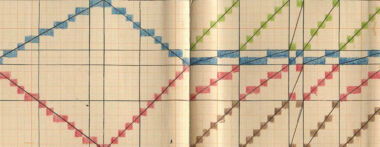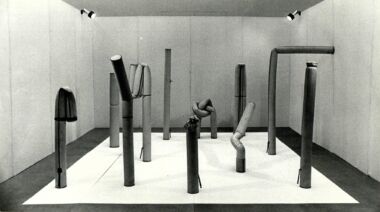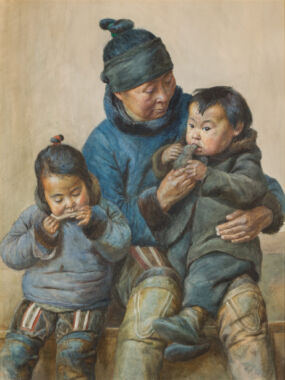Summary
The article focuses on characteristic features of Wilhelm Marstrand’s narrative paintings, thereby serving as an introduction to his overall artistic endeavours. Marstrand’s working method and highly unusual productivity are linked to his distinctive view of man as a social being and his ways of relating to a nationalist art environment, to the traditions of the art of drawing and to the role of the artist.
Articles
In the 1820s, the street of Silkegade in Copenhagen was home to a Norwegian inventor named Jacob Marstrand, from whose desk a wealth of ingenious ideas flowed out: designs for mechanical kneading machines, musical instruments and much more. At Christmas of 1823, the people of Copenhagen could admire the latest invention in the Marstrand home, a panorama that depicted the view from the famous Goose Tower in Vordingborg. Panoramas were a common form of entertainment at the time, usually taking the form of a long painting that encircled the viewers and gave them the impression of looking out from a famous vantage point. But Marstrand’s panorama was something quite different and unexpected: while the painting itself was done by his good friend, professor C.W. Eckersberg, Marstrand had invented a special machine that allowed the audience to sit still while the panorama passed by before their eyes. The viewers could view the landscape go by rather like in a movie in a modern cinema, an experience which undoubtedly challenged their usual way of looking at the world and perceiving images.1
Jacob Marstrand’s panorama opened a few days after his son Wilhelm turned thirteen, and it is an intriguing thought to imagine the boy watching, trying to capture the fleeting images in the constant stream of pictures. Of course, imagining that this experience had any impact on the future course of the young Wilhelm Marstrand’s life would be pure speculation. Nevertheless, the moving panorama can serve as an allegory of Marstrand’s own inner stream of images. As an adult, he became an almost manically prolific maker of images. The breadth of his work and its colossal scope very clearly demonstrates that his imagination was so well-developed that his hand had to work quickly to capture all the mental images conjured up by him.
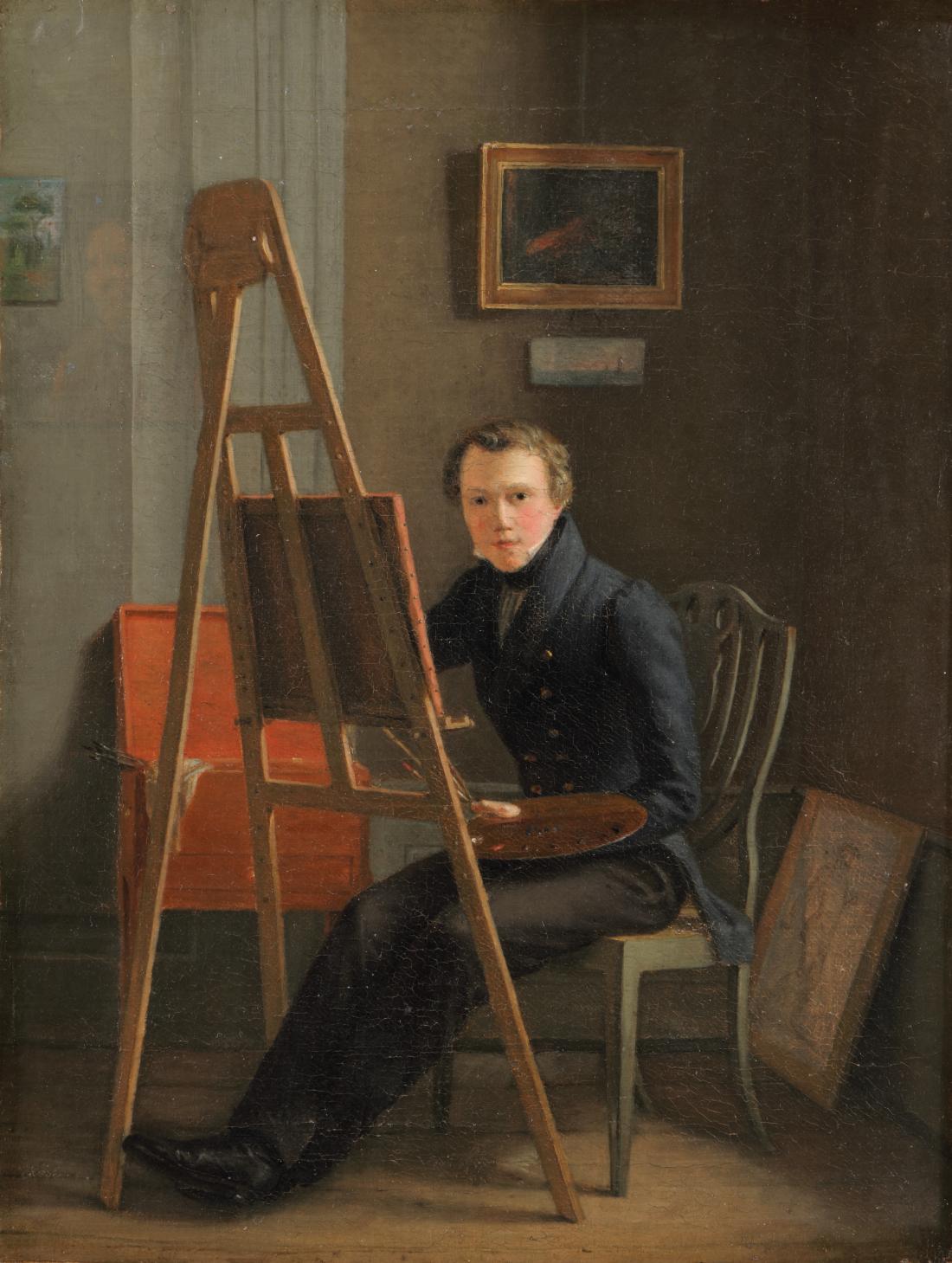
In Marstrand’s older days, this restless versatility prompted the press and the public to regard him as a genius. In fact, few Danish artists have been the subject of such enthusiastic hero worship as Marstrand during the period from the 1860s up until around the First World War. But the tale built up about his person was a rather atypical one, summarised in the first major biography of him, written by the art historian Karl Madsen and published in 1905.2 In this narrative we are presented with a painter who struggles to capture his ideas and translate them into finished works, and who was only too aware of not being able to follow through on the drafts and sketches that came so easily to him. Briefly put, Marstrand’s legacy became the tale of a tragically inadequate genius, caught up in a torrent of images.
Even though almost a century has passed since Marstrand’s pedestal first began to falter, the myth is not without its elements of truth. Marstrand’s versatility is undeniable, and it seems very likely that his good ideas would often be drowned by the steady torrent of new brainwaves and impressions. The sheer quantity of Marstrand’s loosely drawn sketches and half-finished drafts is staggering. But seen through modern eyes, Marstrand’s works also hold qualities that are equally striking, if not more so, than his versatility. The following pages will serve to sum up some of the many aspects that characterised Marstrand and his art compared to his contemporaries, namely his approach to depicting people and the notable ambiguity in his representation of man as a social being; his peculiar way of entering into the discussion on national art; and his constant doubts and questing nature that always admitted the possibility of failure. The hope is that this will help lay down the foundations for an understanding of Marstrand’s immense popularity in his own day and immediate posterity, as well as of the disparaging attitude displayed towards his art over the past hundred years. A main line of inquiry in what follows will be the painter’s image of mankind, a trait of which it can be difficult to form a firm grasp: depending on the eyes that see, it may come across as mocking and leering or as naïvely adoring. In his politics, art and outlook on the world, Marstrand was essentially free of illusions and undogmatic to a degree that seems atypical for the age.
The road to individuality
Marstrand was born into a home rich in social capital when he arrived in this world on Christmas eve of 1810.3 His inventive, if not very commercially savvy father had an extensive circle of friends that included art academy professor C.W. Eckersberg (1783–1853). Given that the young Marstrand’s all-absorbing interest was to draw – especially witty and caricatured images of the people around him – it was only natural that in October 1825, at the age of fourteen, he was taken out of school and enrolled at the Royal Danish Academy of Fine Arts instead. The following year, in the summer of 1826, he also become a private pupil studying under Eckersberg at his studio, where he soon became part of the inner circle and gradually formed friendships with painters such as Christen Købke (1810–48), Constantin Hansen (1804–80), Jørgen Roed (1808–88), Albert Küchler (1803–86) and Adam Müller (1811–44).
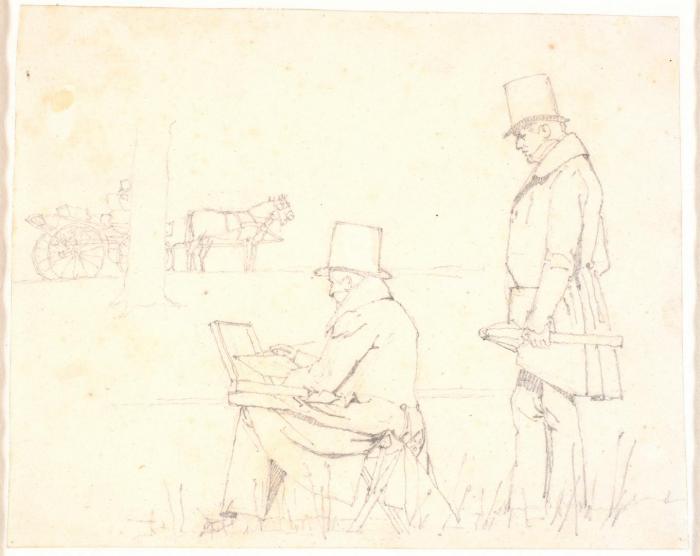
Marstrand entered Eckersberg’s studio at a time when the teaching conducted at the academy underwent major changes, adopting a new focus and new fields of activity. Not only had Eckersberg and his colleagues introduced painting with oil paints as part of the curriculum at the academy during the 1820s, a technique we see Marstrand practicing in a painting by Christen Købke [fig. 1].
The academy professors had also begun to encourage students to paint outdoors. A drawing by Købke that has taken on almost iconic status today shows the 21-year-old Marstrand during a study excursion to the Dyrehaven park north of Copenhagen, closely observing Eckersberg working with brush and oil paint [fig. 2]. A few months after Marstrand had won the academy’s major silver medal in March 1833, thereby officially graduating from the academy, he witnessed yet another new departure in Danish fine art education: in the summer of that year, the academy began allowing its students to study after female nude models, and Marstrand took part in some of the earliest of these life classes [fig. 3]. By their very nature, such studies were first and foremost exercises in depicting anatomy and delicate skin tones, all in order to ultimately translate the lessons learned into history paintings.
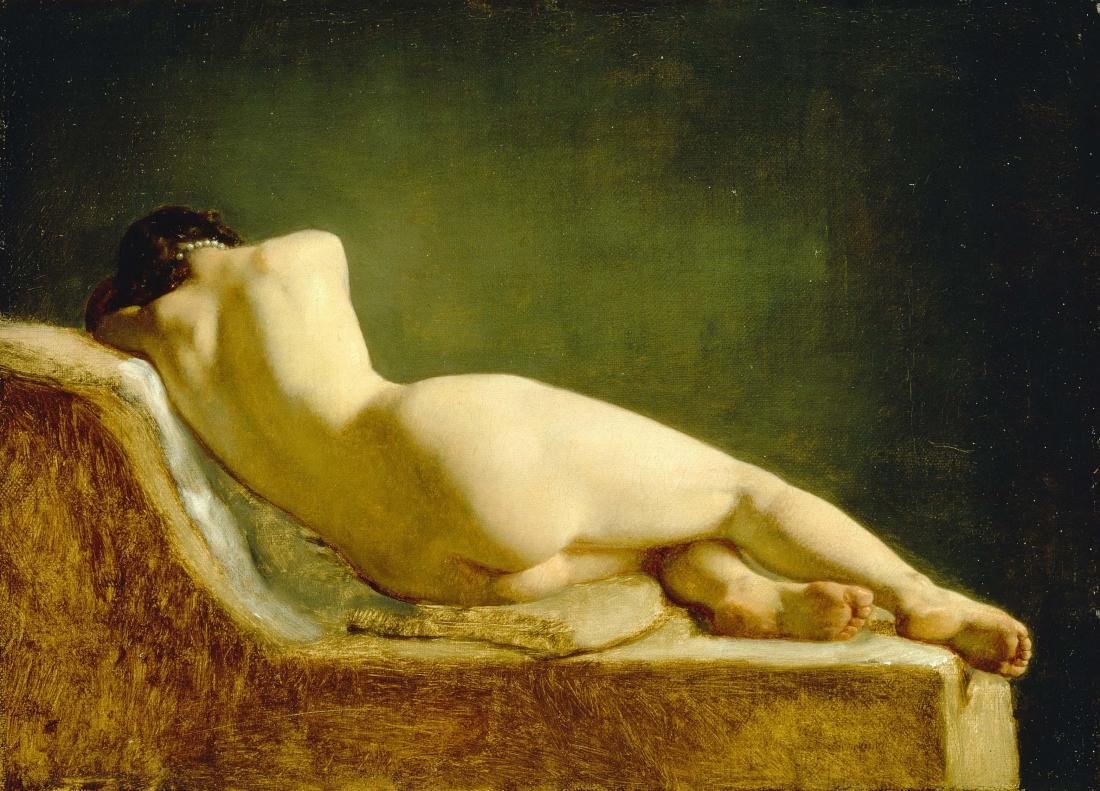
Portraits was yet another genre that gave young artists the opportunity to simultaneously practice their technique and seek to convey a personal expression. From the late 1820s to the mid-30s in particular, academy students painted and drew an overwhelming number of portraits that were rarely commissioned works; rather, they tended to arise out of focused explorations of the particular psychology and tools pertaining to the portrait genre. Several of Marstrand’s friends, including Købke, Roed and Constantin Hansen, cultivated varieties of an intimate portrait type that create the illusion of a direct connection between the spectator and the sitter. We engage in eye contact with the person portrayed and can imagine ourselves being in the middle of an informal conversation, a feeling often shored up by the sitter’s informal, home-like dress, relaxed pose and unfeigned facial expressions.
Marstrand would also occasionally try his hand at this intimate form of portraiture and in fact painted one of the true gems of the genre, depicting friend and fellow artist M.G. Bindesbøll (1800–56) smiling while seated backwards on a chair [fig. 4]. Generally, though, Marstrand seems to have preferred a different path in the 1830s. At any rate, he repeatedly portrayed his sitters with a distant and dreamy gaze; a marked difference from the palpable presence evident in the portraits painted by his friends. It would appear that he took his starting point in Eckersberg’s famous portrait of Bertel Thorvaldsen, then as now the property of the Royal Danish Academy of Fine Arts, in which the sculptor is depicted with air of rapt inspiration, his eyes turned to the heavens. Remarkably, Marstrand did not only choose this form of portraiture for artistic temperaments like Eckersberg [fig. 5] and the Holstein art expert and cookbook author C.F. von Rumohr (1785–1843), but also when painting portraits of ordinary men, women and children. This is to say that while his peers from the academy were attracted by the direct connection between people, Marstrand seems to have been more concerned with giving the impression of spirituality and a rich inner life. His early portraits became a concrete expression of the importance of the realm of thought in his art – of humanity’s vivid, almost insistent faculties of imagination.
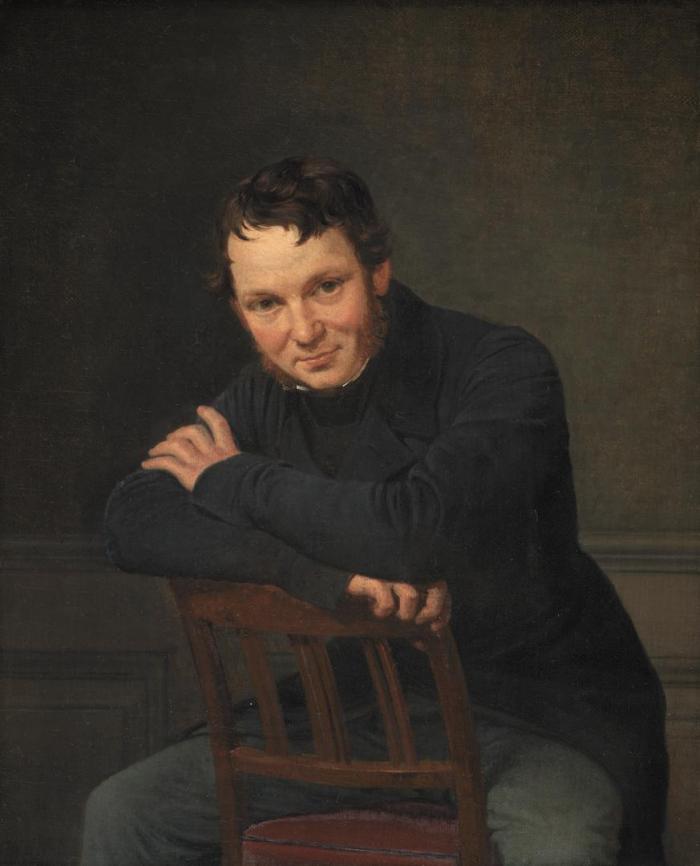
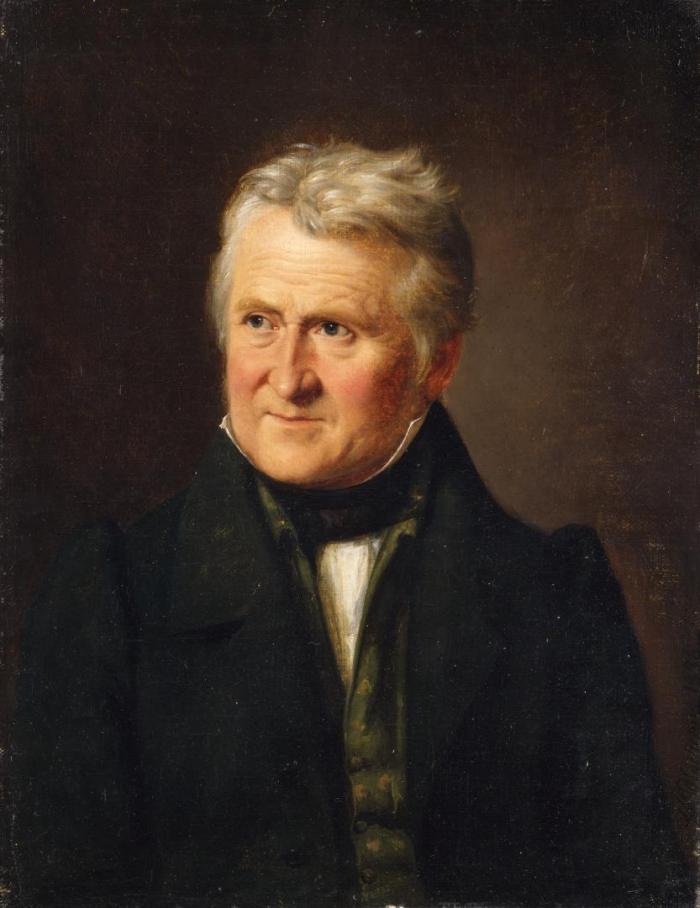
Marstrand’s view of man
The fact that Marstrand chose an ideal portrait form rather than a more earthbound variant may be regarded as a deliberate move away from the individual and particular, aiming instead to capture universal human traits. Such an approach was already evident in some of his earliest works from the Academy of Fine Arts’ annual juried exhibitions, where he began exhibiting his humorous street scenes in 1831 [figs. 6-7].
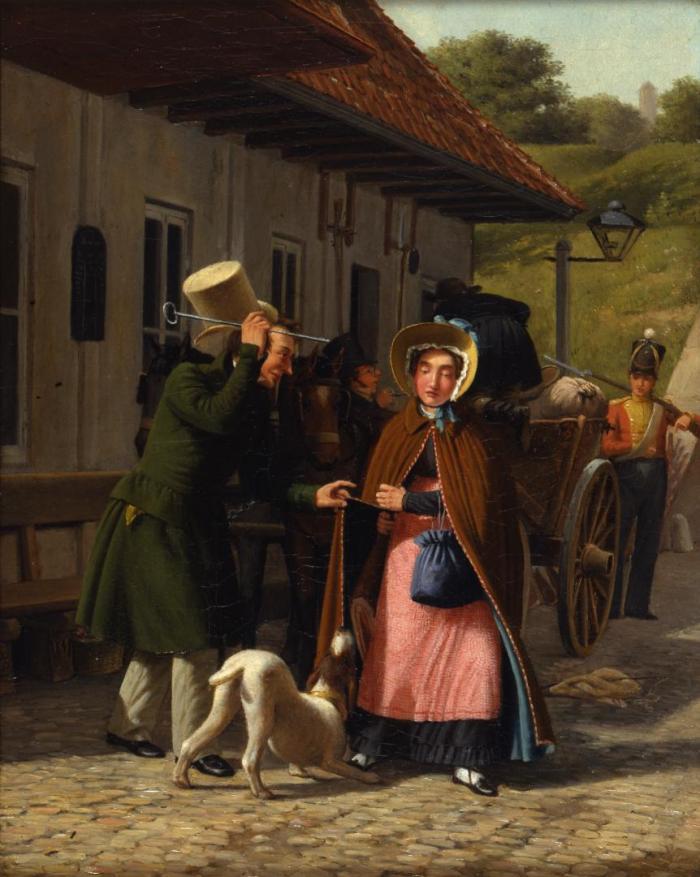
It should be noted that Marstrand’s breakthrough as a humourist coincided with the emergence of a popular vein of humour that permeated almost all the arts and all strata of society.4 Not only did the vaudevilles of J.L. Heiberg and Henrik Hertz attract audiences to the Royal Danish Theatre in the second half of the 1820s – the bourgeoisie was also overcome by a mania for rather more robust, even groanworthy jokes known as ‘Kældermænd’ – literally ‘cellar-men’. Taking the form of riddles, they often involved puns. One example might be: ‘In which houses are most balls held?’, To which the answer was: ‘In the billiards houses’. The mania for these lowbrow jokes is remarkable in that it pervaded all walks of life – to such an extent that contemporary sources report that for a time they made any genuine, polite conversation impossible. Equally remarkable is the fact that this craze for low wit reached its peak in March 1831, the very same month that Marstrand exhibited his first street scenes. While new booklets compiling the popular cellar-men jokes were published weekly, the twenty-year-old painter offered a similarly cheerful and jesting outlook on everyday life. His street scenes are, thus, expressions of the general popular humour of the times.
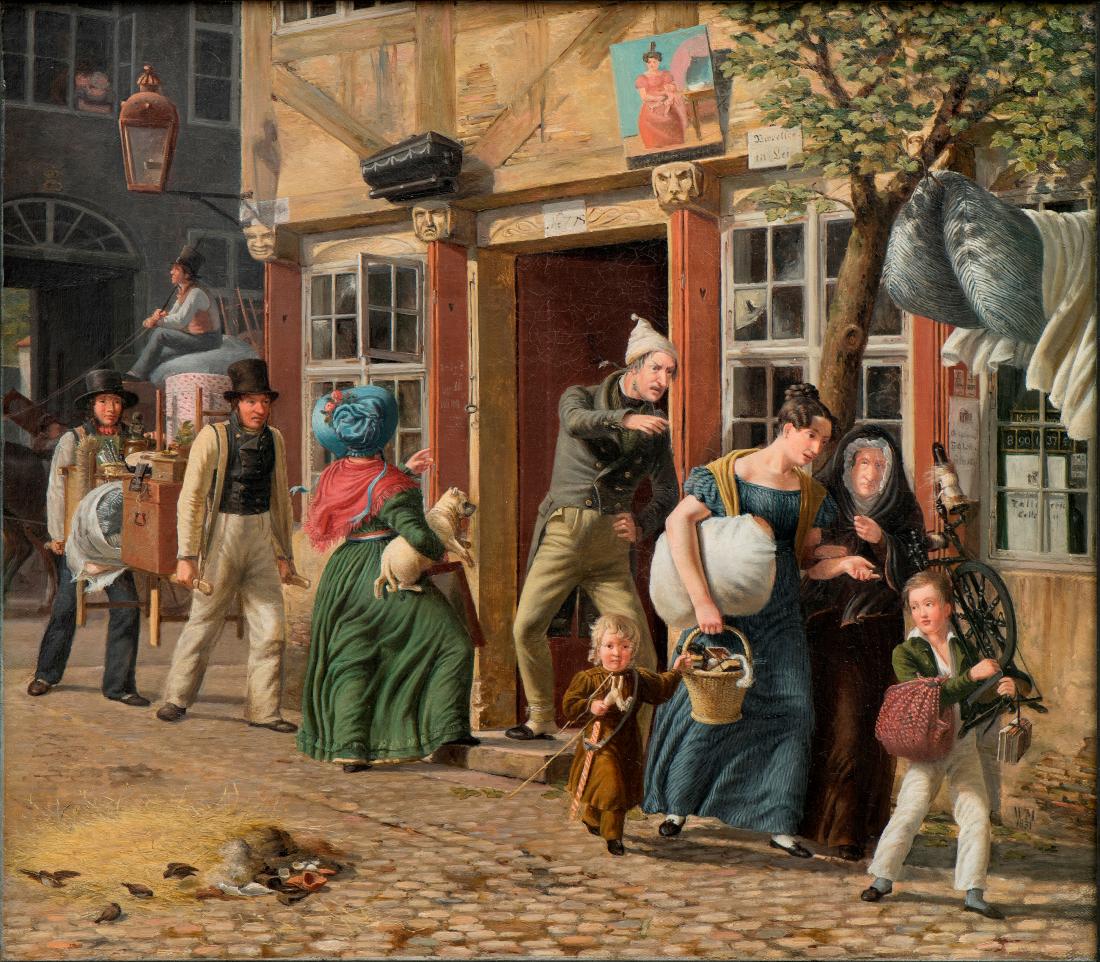
The first two street scenes by Marstrand presented to public view were his Scene from a Toll Booth [fig. 6] and Moving Day [fig. 7].5 Both were received with great praise and were immediately purchased for Kunstforeningen (The Copenhagen Art Society), an important meeting place for art lovers in Copenhagen. But even though the humour appears coarse and shallow at first glance, the message may run deeper than being simply a moral injunction about the follies and vices of city dwellers. For example, the Scene from a Toll Booth shows us how the peasant woman’s attempt to smuggle a ham through the Vesterport gate is thwarted by the pointy-nosed customs officer and his dog. In the background is a sentry guard protecting the privileges of the royal city against the farmers entering from the surrounding provinces. And above the tree tops behind him, we can just make out the Liberty Column originally erected to gratefully acknowledge the granting of partial freedom to the peasantry, bestowed by the grace of the king in 1788. While the joke dominates the foreground, the background’s juxtaposition of soldier and obelisk may convey a more serious statement about the scope of the liberty reforms. Freedom and its limitations presented in one and the same image.
The following year, in the spring of 1832, Marstrand’s most famous painting in the genre was presented to the public: Street Scene. Dog Days [fig. 8]. Once again, the message evident on the surface concerns the folly of the citizens. According to the leading art critic of the time, N.L. Høyen (1798–1870), we are witnessing an amusing misunderstanding between a dog trainer and dog catcher: the latter is trying to catch a stray dog, but the dog trainer mistakenly believes that he is targeting his flock of pedigree dogs and according attacks in their defence.6 The work parades the follies of conceit and hot-temperedness, but perhaps we may also make out a level of political satire in this scene. One could certainly choose to interpret the scene to say that the well-bred are protected while those of less noble stock are more at risk – that in class society, we are not equal in the eyes of the law.
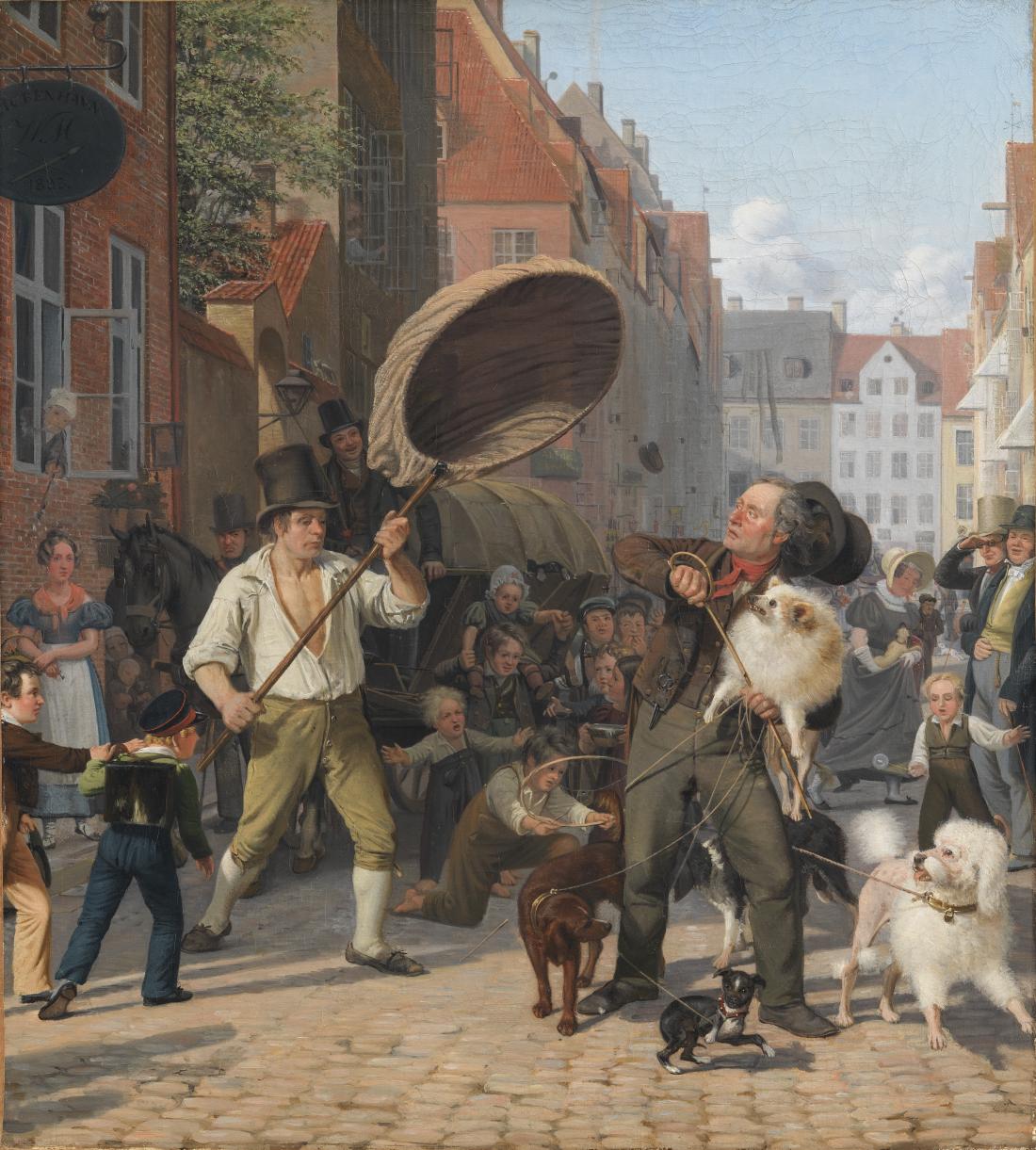
Although Marstrand’s street scenes can hardly be described as social critique, they do, all things considered, display a more sincere interest in other people’s conditions than he is generally given credit for. The humourist’s seemingly superficial way of reducing the people of the city to primitive, one-dimensional types – the tight-fisted, the lazy, the villainous – has been the subject of greatly varied interpretations. The art historian Henrik Bramsen (1908–2002) represents a relatively recent view of Marstrand: in 1990 he described the humour as harsh, vicious and unkind, while also finding traces of sadism and brutality in the depiction.7 This reading contrasts sharply with how the street scenes were perceived back in their own day, as related by Julius Lange in 1865: ‘Even if a certain amount of leering can also be found here and there in these pictures, the main impression conveyed by them remains one of free, pure and innocent comedy’.8 One should, then, be careful not to read too much cruelty into Marstrand’s genre pictures. Modern viewers might easily fall into the trap of viewing these street scenes as examples of real people being ridiculed and shamed – as if the artist was kicking out at those less fortunate than himself. However, his own contemporaries were apparently better able to read the paintings as a kind of Punch and Judy show, offering an exposition of human characteristics that harboured no illusions about mankind, but which was not really malicious to real people or specific social classes.9 Marstrand’s genre paintings were very much created to appeal to the common man, becoming accordingly widespread. Not only were the annual exhibitions in Charlottenborg a very popular entertainment at the time, drawing quite astonishing crowds.10 The humorous street scenes were also reproduced as lithographic prints in the various journals of the time and as individual sheets, thereby reaching even wider audiences – albeit often several years late. Even though a given painting was, by the very nature of things, intended for a single buyer with an interest in art, its subject matter could be far more widely viewed and appreciated by the very people who, to present-day sensibilities, appear to be the subjects of ridicule.
The fact that Marstrand’s human figures should not be perceived as offensive caricatures, but rather as depictions of something universally human, adds greater nuance to the outlook of art associated with the period, which is often – and rather simplistically – regarded as being entirely defined by the teachings of Eckersberg. According to the professor’s writings, which are by no means unambiguous, the artist’s objective was to depict the true image which nature first allowed him to glimpse, and which knowledge of the laws of nature enabled him to perfect. For the painters of the period, of which there were many, this view of art finds expression in an interest in the study of nature and, hence, of the intimate and specific. This is especially true of painters like Købke and Martinus Rørbye (1803–48) and genres such as landscape painting and intimate portrait painting.
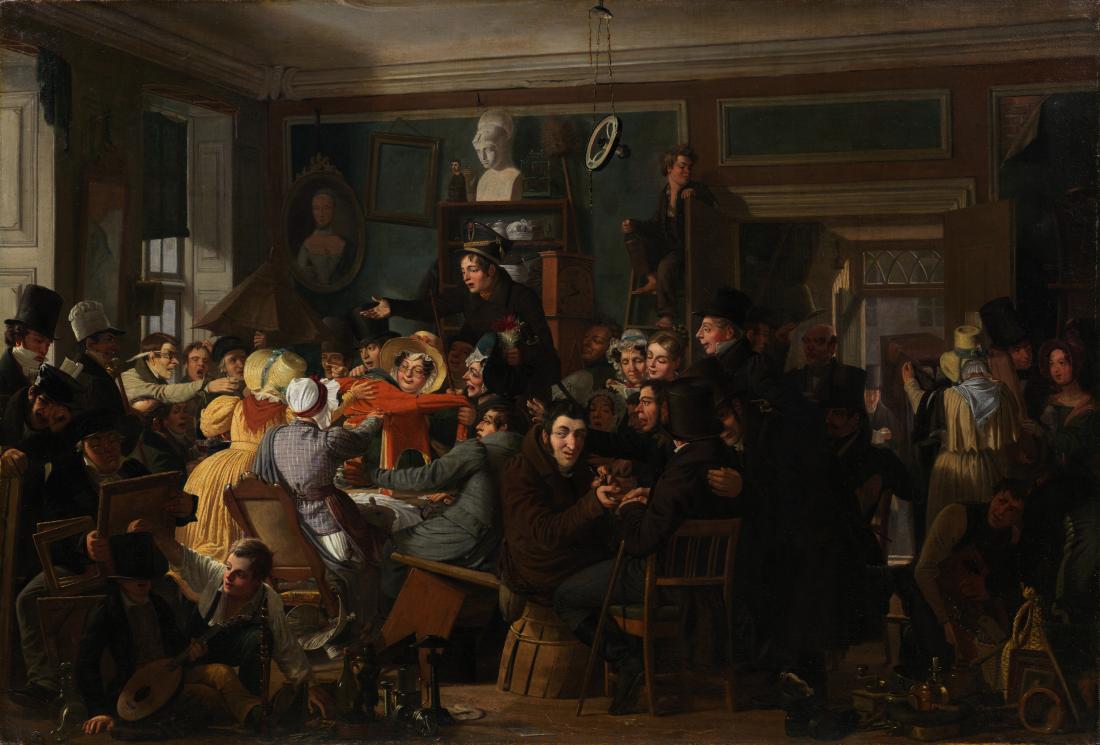
Marstrand, on the other hand, painted almost no landscapes, and his depictions of figures are generally not about individuals, but about human types. This comes to the fore in a painting like Scene from an Auction from 1835 [fig. 9], where we witness a perfectly everyday sight at the time: an auction of chattels, attracting a throng of citizens eager for a bargain. The main narrative focuses on the womenfolk engaged in a fierce struggle for a red uniform coat, but the chaotic scene also gave Marstrand the opportunity to create a wealth of depictions of distinctive physiognomies that a modern observer would not hesitate to describe as caricatures. However, it should be noted that these are not caricatures of specific individuals – rather, they offer a way of representing universal human traits such as wrath, covetousness, vanity and sloth. Marstrand thus represents his own branch of ‘Golden Age’ art, one which focuses on the general rather than the specific – not on places, situations or phenomena, but characteristics. In this, we may find the seeds of later generations’ lack of understanding of Marstrand’s portrayal of human beings, which simply did not satisfy posterity’s fervent wish to always see nature mirrored in art.
In his own day, Marstrand’s street scenes sparked a wealth of imitations. In 1832, Martinus Rørbye sought to elevate the genre to a more ideal level, borrowing a conceit from the seventeenth-century painter Caesar van Everdingen and letting a modern-day version of the misanthropic philosopher Diogenes walk the streets of Copenhagen with a lamp in full daylight.11 Around 1833, the slightly younger painter Edvard Lehmann (1815–1892) created a painting of the perils of the street, humorously placing the scene outside the very same house where Marstrand lived.12 To put it briefly, the young Marstrand – only 22 at the time – was generally accepted as the master of the genre, the one to whom all others must relate. When, a few years later, he exhibited his Scene from an Auction alongside a smaller picture of a woman with her dress caught in the front door, it prompted one reviewer to enthusiastically reaffirm Marstrand’s talent for comedy:
Anyone looking to have their lungs stirred up need look no further than Mr Marstrand’s sketch no. 96; it will surely not fail to exercise its Wesselesque effect. As small as it is, it nevertheless offers a bright flash of its master’s keen sense of comedy; it is like a prelude for the play awaiting us in the ‘Auction Scene’ by the same artist. […] Indeed, the audience’s laughter is the best possible praise that could be heaped upon this most excellent sketch.13
However, while the comic street scenes won him popular attention and critical acclaim, they also firmly assigned Marstrand the role as a humorous painter; a typecasting from which he would later struggle to extricate himself.
Great ambitions
The young academy students enjoyed a great degree of freedom to experiment with informal subjects and break down the boundaries between the different genres of painting, if only they remembered to observe the more firmly set conventions when it came to the more prestigious and saleable genres. History painting remained the leading genre, and Marstrand did not oppose to this view. On the contrary, he dutifully took part in the competitions for the Academy of Fine Art’s gold medals, which were awarded for the best rendition of a given biblical or literary subject. However, it would appear that his reputation as a humorous storyteller became his greatest obstacle.
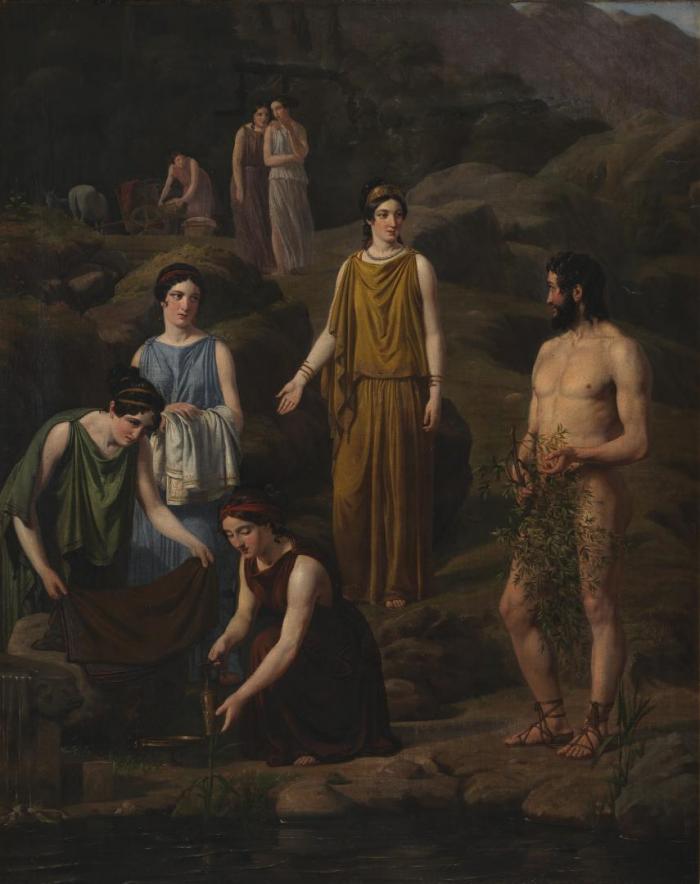
In 1833, when the assignment set for those wishing to compete for a gold medal was a portrayal of the Flight into Egypt, Marstrand’s sketch was initially approved for execution, but in the final assessment there was general agreement that he would not be awarded the prize, but had to settle for a special commendation.14 The depth of Marstrand’s wish to prove his worth as a history painter and thereby earn himself a travel scholarship is evident two years later when he once again had the opportunity to compete for a gold medal. The subject was Odysseus and Nausicaa, but at the time the competition was about to begin, Marstrand was travelling in Norway alongside landscape painters Louis Gurlitt (1812–97), Johann Mohr (1808–43) and Johann Heinrich Martens (1815–43), and the irregular steamboat shipping service prevented him from getting back in time. However, his letter of apology did arrive in time, enabling Eckersberg to ask for an exemption on his behalf. The next day, Eckersberg was able to pick up his student on the dock, rushing him off to one of the small wooden cells given to each contestant in which to work.15 All their efforts came to nought, however: once again, Marstrand received neither a prize nor a grant [fig. 10]. The academy’s professors and other members presumably concurred with the art critic who found that Marstrand had too extensively ‘perceived the comedic aspects of the given situation’. The critic was particularly struck by the inappropriateness of the hero’s apparent embarrassment at his nudity, the princess’s slightly suppressed smile and the mischievous, indulgent or curiously whispering maids.16 The critique speaks eloquently of how Marstrand was regarded as humourist through and through; a view that apparently prevented audiences from appreciating his efforts in a more serious genre.
The fact that Marstrand repeatedly competed for gold medals to no avail was by no means unusual – in fact, it had become very rare for the major gold medal to be awarded to anyone. More interesting in this context is Marstrand’s reaction, which is symptomatic of his involvement in art politics, one which lasted his entire career, as well as of his rebellion and self-awareness as a member of the artist’s profession. In a letter to his friend Constantin Hansen, he vented not only his disappointment with the Academy Council’s decision, but also his bitterness towards the Academy’s position of power in the Danish art scene in general:
You may be aware that the most exalted academy has not deemed me worthy to rest in the shade of their Tree of Knowledge, nor to drink from the Hippocrene fountain which trickles only sparingly from Mount Parnassus onto the Kongens Nytorv square. […], but we have a saying here lately, which goes – ‘it is all the same’ […] a calm reassurance has come into my soul that I did not know before, a striving to grow independently, and a clarity about the way this should be done now fills me […] . If there is anything original in me, then it will certainly be allowed to act exactly as it wants; once the soul has reached a certain maturity it should not be bound. It is by myself that I shall make something of myself, others cannot make me so, and I will show them that I am not afraid to stand on my own two feet. If even winged Pegasus himself will not allow me to sit proudly in the saddle, I shall still catch hold of its tail […].17
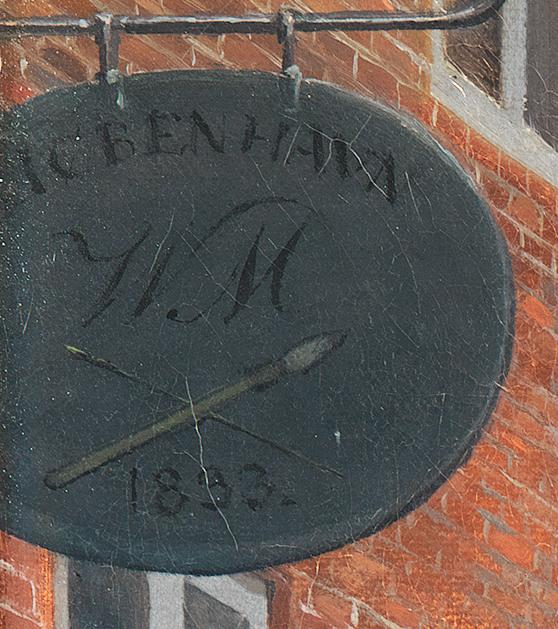
In fact, Marstrand’s ambition was to extend his reach to include the highest and lowest genres of art alike. In Street Scene. Dog Days [fig. 11] he has incorporated his own signature in the upper left corner, painting his name and the date on a painter’s street sign, which is also decorated with a pair of criss-crossing brushes: one small and delicate, the other large and broad. Just as in the real streets and alleys of the city, this sign was an advertisement, in this case proclaiming the young Marstrand’s willingness to undertake all kinds of tasks, even the demanding decorative assignments.
Carefree Italy
Foundering in the competition for a gold medal in 1835 made Marstrand defiantly turn his back on the usual career path of academy-trained artists, at least for a time. In March of the following year, he submitted an application to the royal foundation in charge of supporting the arts and sciences, Fondet ad usus publicos. Tellingly, he did not insist on the rank of a history painter here, but signed off as a portrait and genre painter.18 His objective was to obtain funding for a two-year trip abroad, and as a portrait and genre painter the Academy was able to give him their warmest recommendations ‘as the most talented and most highly developed young artist within his discipline’. The money was pledged to him, and in mid-August Marstrand travelled via Berlin and Dresden to Munich. After a few weeks in the Tyrol, he continued via Switzerland to Italy, where he arrived in Rome on 3 December 1836.
Life in and around Rome was overwhelmingly rich in subject matter for a genre painter, so it is hardly surprising that the flow of images created by Marstrand grew in strength and scope. A month after his arrival, he wrote to Eckersberg: ‘I have seen much, almost too much, for I am overflowing with ideas and one displaces the other, with not enough time for the soul to properly process them’.19 For the rest of his life, Marstrand would return to Italian subjects that he had seen and experienced only once. Even sketches that appear to be based on immediate observation may have been committed to paper decades later, making any attempt to date his thousands of Italian scenes almost doomed to fail.20
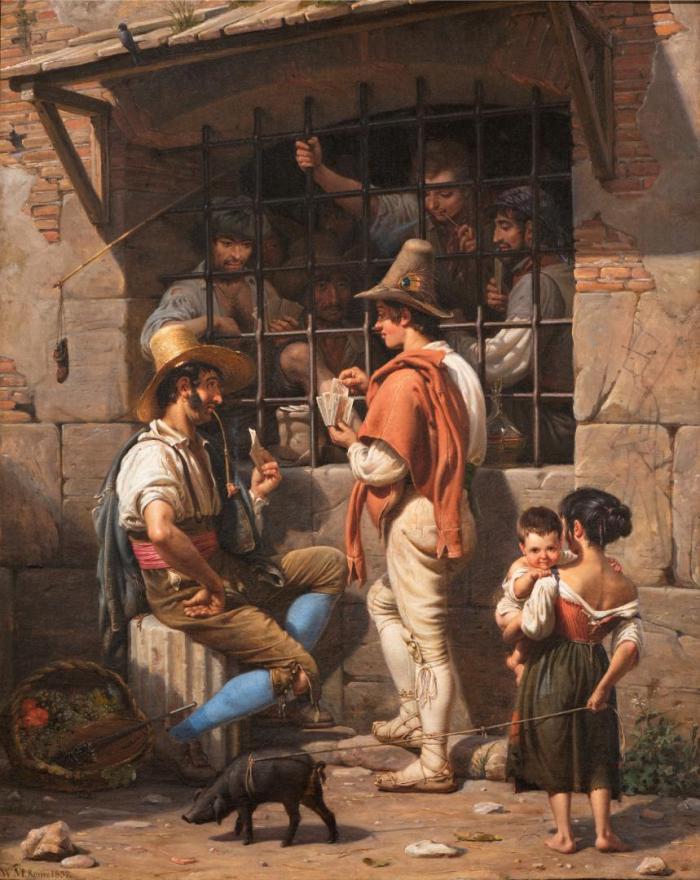
Marstrand’s first journey to Italy was not only important because it gave him new and rich fuel for his image-making imagination. His time there would also prove decisive for the overall direction of his portrayal of people: in his depictions of Italian folk life, he distanced himself from the comedic street scenes from Copenhagen. His view of the Italians was markedly different from the one-dimensional types he had painted in Denmark. The Italians had a more alluring ambiguity: their naturalness and carefree lives were admirable, but the lack of onerous seriousness was also the trait that made them involuntarily comical. More than any other Danish artist, Marstrand united deep respect with loving ridicule in his Italian genre pictures. Over and over, Marstrand’s Italian images are about la dolce vita under the southern skies, even as he also takes a wryly ironic look at the childish naïvety that underpinned it.
This duality was already evident in his first Italian genre piece, A Prison Scene in Rome, commissioned by Kunstforeningen back home in Copenhagen [fig. 12]. The theme is the Italians’ astonishingly laissez-faire attitude towards justice and punishment. The prison has a street-level window that allows the criminals to take part in city life; a canopy protects them from the rain and sun while their friends on the outside come round for a game of cards. The fruit vendor even looks on magnanimously while his younger, well-dressed companion appears to be having his cards clandestinely read by the incorrigible prisoners. The authorities are nowhere to be seen; indeed, urchins have even had the effrontery to draw a caricature of a gendarme on the prison wall itself. Where a Dane would expect harshness and consistency on the part of the authorities, we here observe a sense of indulgence and, perhaps, a greater sense of humanity.
The duality of this carefree existence obviously runs much deeper than the superficial view of Italian life as it appeared the eyes of many travellers. Marstrand himself complained that most genre painters of the age tended to overlook the importance of portraying the true character of the people, focusing too much on external appearances:
Here one usually hears the genre painters speak of the lovely costumes, beautiful scenes of buildings and trees et cetera as if the inner, spiritual expression of the human condition resided in the outer shell. Just see what Holberg was able to see in the Danish nation.21
Thus, Marstrand regarded the depiction of the people’s customs and outlook on life as a point of entry of their ‘inner, spiritual expression’. As he put it in a letter to his brother Osvald in March of 1840: ‘in the small things in life we learn to see the big picture’.22 And Holberg offers a point of reference for understanding and portraying a people’s character. One point where Marstrand might have studied Holberg in particular depth concerns the unspoken ambiguities of different types. In Holberg, the character of Erasmus Montanus is ridiculous in the eyes of the audience as long as he conceitedly bandies false wisdom around – but when he is brought low on a matter where he is actually right, he at once becomes simultaneously ridiculous, pitiful and strangely sympathetic. In Holberg and in Marstrand’s Italian pictures, the comic figure is reminiscent of an ambiguous image; slowly, almost imperceptibly, they take on universally human features in the eyes of the audience. This endeavour to balance sympathy with gentle ridicule also found expression in Marstrand’s next major genre painting, which depicts the traditional celebration of the Feast of St. Anthony, held in the week following 17 January [fig. 13]. On that occasion, the Italians would bring their livestock to the church for a blessing, which in the eyes of the Nordic artists was a touching example of folklore and popular belief in the midst of a laughable chaos of baying and howling creatures. At once solemn and utterly comical, this subject was as if made for Marstrand.
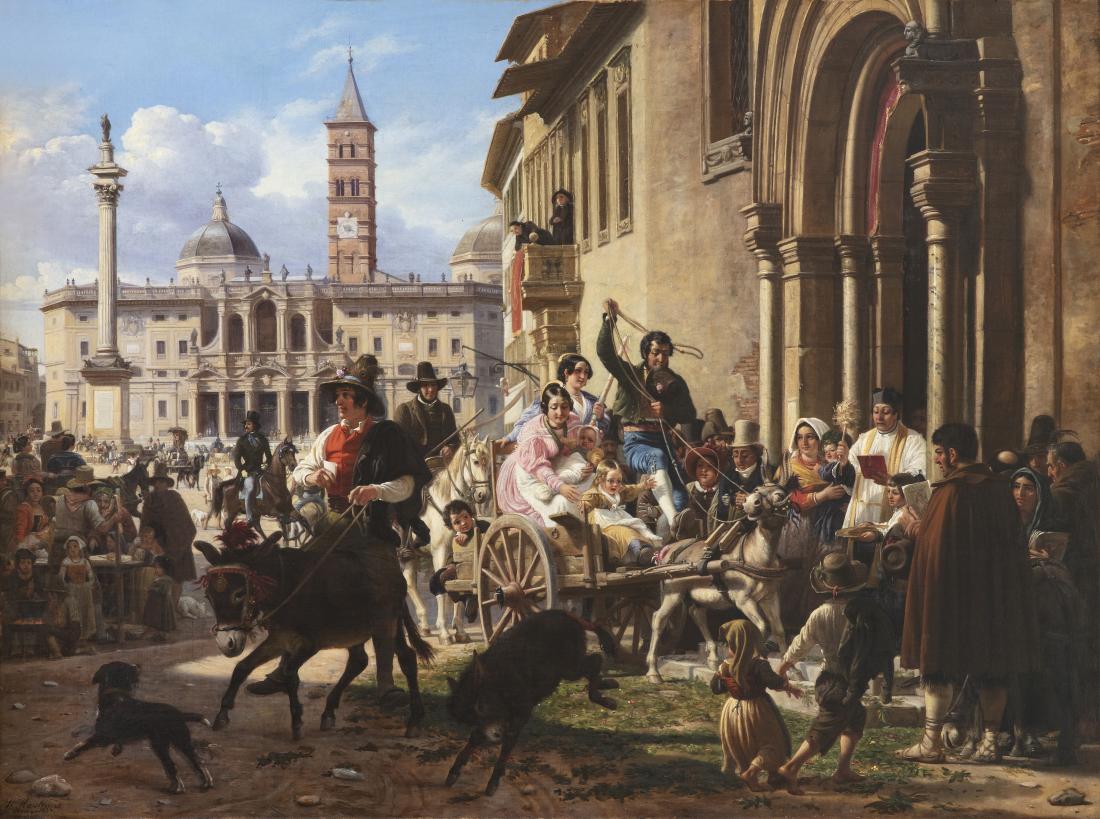
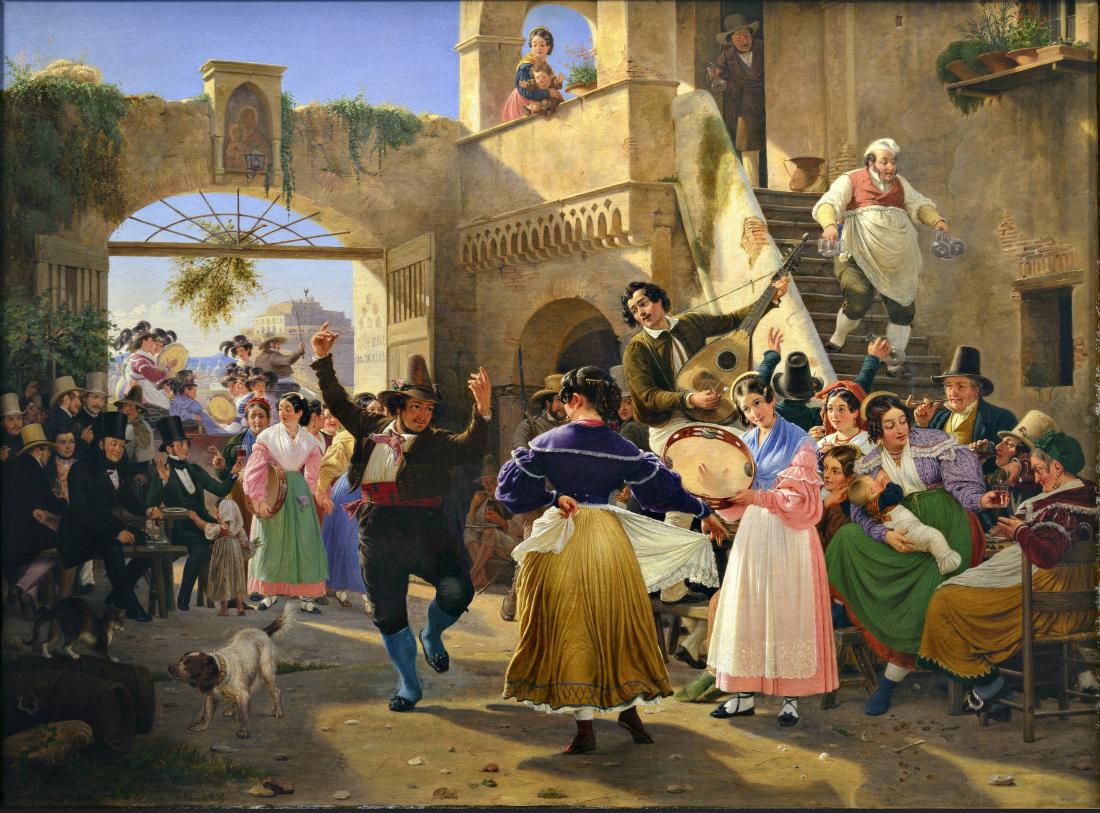
Naturally, the subtle comedy of everyday life was particularly pronounced in the eyes of strangers unfamiliar with what they saw. Many travellers – perhaps most of them – would have become aware of their role as outsiders, as uncomprehending spectators to customs that did not always make sense to them. This role as spectator was the subject of Marstrand’s next major genre piece, depicting a scene of merriment outside a Roman tavern [fig. 14] – a subject which, as noted by Charlotte Christensen, was strongly inspired by the painter Franz Catel. To the right, locals amuse themselves with wine and dance. The host is rushed off his feet and failing to meet demand – the decanters are empty both above and below the stairs. Outside the gate, a group of young women arrive to further fan the flames of the fun. The Nordic guests to the left fail to become part of the party, settling instead for a spot as observers on the sidelines. A well-intentioned attempt to offer a woman a glass of wine is sternly rebuffed by a chaperone raising an admonishing finger. The Danes are strangers here, so much outside of their element that the wine merchant Waagepetersen – who commissioned the picture – even sticks to water. In one of the studies, the gift being rejected by the chaperone was not even a glass of the local wine, but a foamy glass of beer.23 Marstrand depicts the two nationalities as two separate worlds that cannot possibly truly take part in each other’s lives.
One of the main themes of Marstrand’s Italian images concerns how the merriment and pleasures of Rome seemed to be an intrinsic part of everyday life. For example, his favourite motifs included a scene where young Roman men and women have effortlessly and self-indulgently built an improvised swing in the tavern door. Wine, fun and dance were as natural parts of life as work, and Marstrand elaborated further on this observation in what may be his most famous Italian genre painting: a depiction of a group of Romans on their way home from festivities during the wine harvest in the regions around the city [fig. 15]. The scene appears to be set outside the Porta Pia city gate, which we must imagine being on the left outside of the picture before us. The building on the right seems to be the inn ‘Mezzo miglio’, which (as the name implies) was located approximately one kilometre from the city gate. We see, then, that Marstrand has greatly condensed the topography of his scene for the sake of composition, placing the inn quite close to the city wall – further shortening the distance between fun-filled celebration and everyday life. Martinus Rørbye, who generally did not look kindly on Marstrand, remarked with approval that in this picture his fellow artist had beautifully captured the Italian ‘Folk Character’, encapsulating the heart and soul of an entire people in a single act.24 Just like his Copenhagen street scenes, Marstrand’s outlook on humanity was still carried by generalisations, but perhaps he now applied a more unambiguously sympathetic gaze.
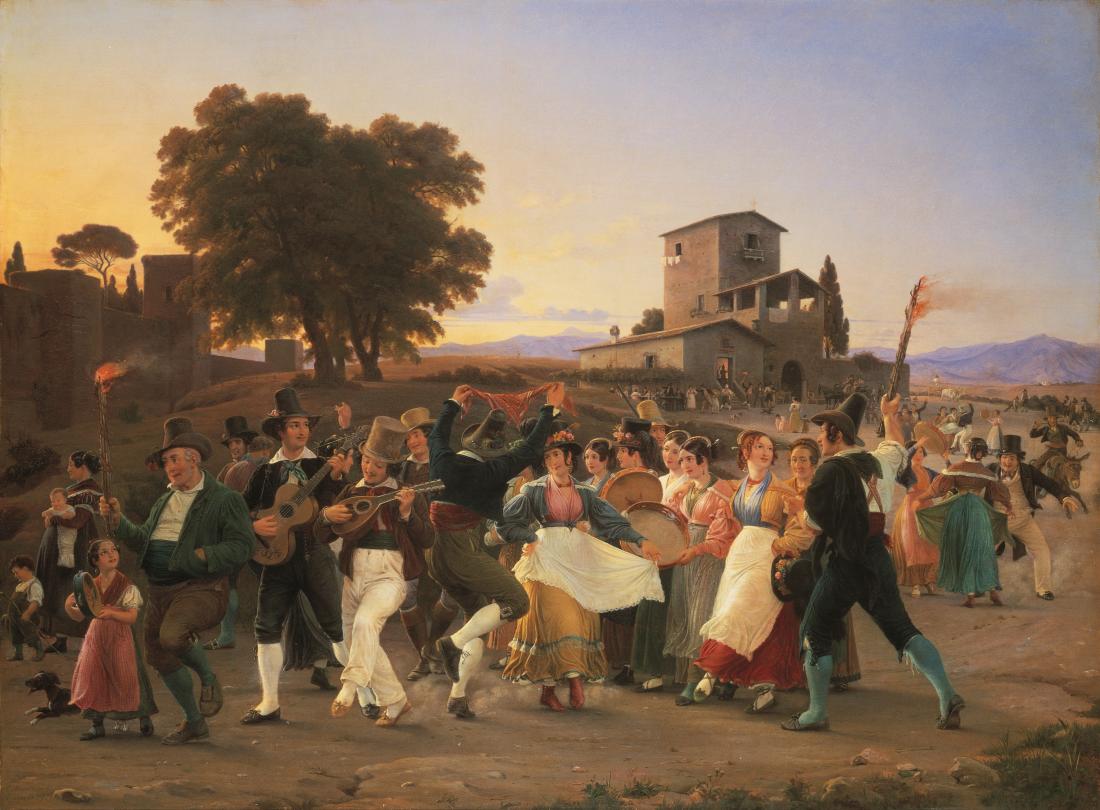
Like the prison scene and the Feast of Saint Anthony, the osteria scene and October Festival Evening Outside the Walls of Rome also contain a sense of wonder at things and issues that are strikingly foreign. Often, such wonder had to do with gender roles and the place of faith in everyday life, which would probably have puzzled the Scandinavian visitors more than anything else. To a Danish observer, Roman folk life presented a decidedly unaccustomed role for women: the women of the South were perceived as much more free, unshackled by convention, yet never really approachable. And this female role found its counter-image in the mannish, rather more comic female figure represented in the osteria scene by the firm chaperone. Several of Marstrand’s ink drawings depict such a matronly figure riding side by side with a monk – he riding sidesaddle, and she riding astride25 – firmly establishing who was wearing the trousers. On the whole, the clergy were one of the only social groups that Marstrand would describe as absolutely ridiculous, pulling no punches and adding no nuance. His favourite types included monks flirting with the young women, and well-nourished priests fobbing off the beggars with a quick blessing [fig. 16]. The second group that Marstrand would mercilessly lambast was the tourists, whose reputation and achievements were summed up in his painting of the well-fed English traveller falling asleep in his gondola [fig. 17].
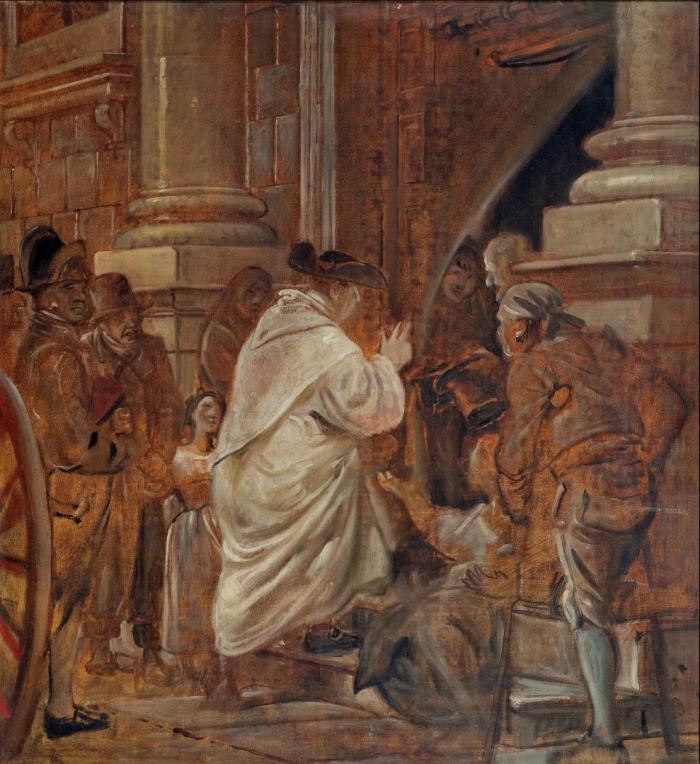
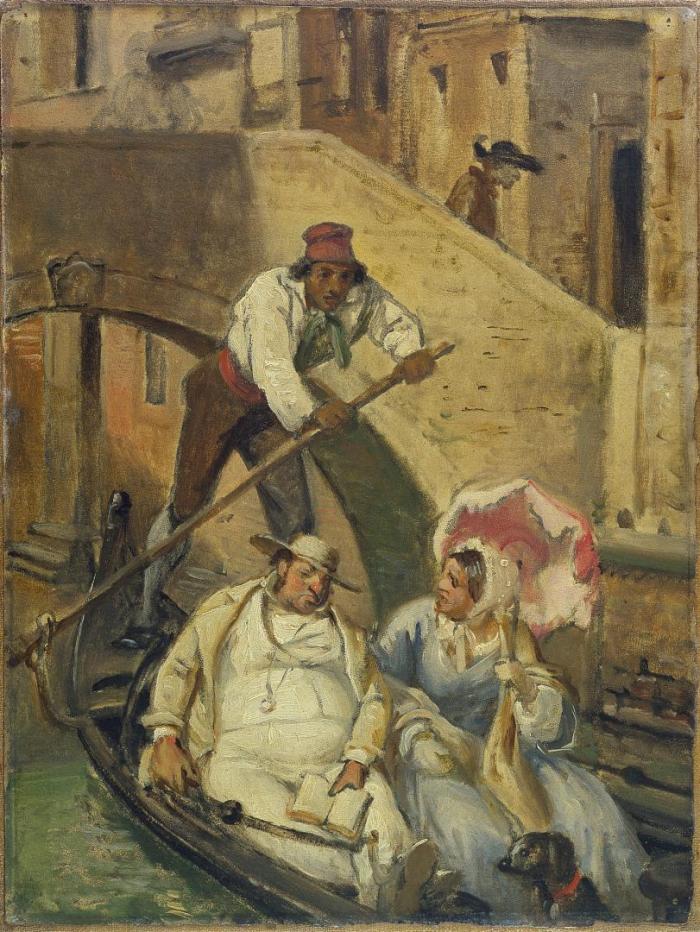
In international waters
Marstrand’s first sojourn in Rome proved decisive for his international outlook and, thus, also for his ambitions on behalf of Danish art. In Rome he took part in the diverse art scene and diligently exhibited his art side by side with the other foreigners at the city’s annual exhibitions. Back then, one would generally find that the Danes in the city mingled mainly with each other and the other Scandinavians. The German artists, on the other hand, remained casual acquaintances only for most Danes, someone one might occasionally see at artists’ celebrations and excursions, but with whom one would only rarely engage in artistic exchanges. For example, Marstrand joined Rørbye and Bindesbøll in singing in a choir set up by German artists, but he did not leave things at that; he was among the few Danes who also formed very close friendships with foreign artists.26 In fact, the friendships grew so strong that he would even bring home their portraits, including one of the Swiss history and genre painter Albert Landerer (1816–93), who would later become famous for National Romantic scenes from his country’s illustrious past.27 Another ‘good friend’ was Johann Wilhelm Schirmer (1807–63), who was a professor at the art academy in Düsseldorf – an institution generally regarded as anathema to all Danish painters thanks to influential formers of opinion such as N.L. Høyen.28 One will frequently see the Danes’ letters and diaries referencing the oft-repeated objection that the Germans (like the French, Italians and other foreigners in general) did not know how to draw and lacked proper knowledge of perspective. Marstrand, however, was by no means prejudiced against German artists, and he particularly admired their use of glazes to create luminous colours, an effect he sought to emulate in paintings such as the aforementioned October Festival Evening Outside the Walls of Rome.
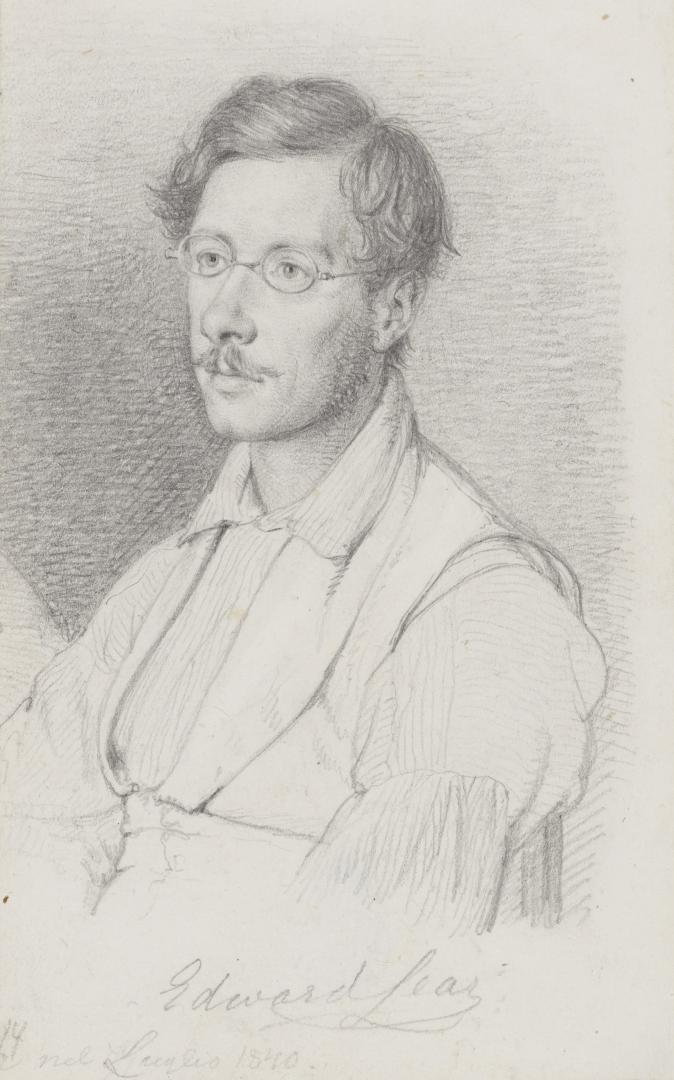
Perhaps we can form some idea of the cosmopolitan environment in Rome through Marstrand’s use of models. Particularly distinctive models could achieve great fame in the city, and the artists arriving there were keenly aware of the renowned models that had previously appeared in famous works. One of the models whom Marstrand sought out during his later sojourn in Italy was Giacomo Orlandi, who can be recognised in a double three-quarters portrait from 1846 depicting A Fisherman and a Farmer.29 Orlandi already had a well-established name among the foreign painters in the city and was on his way to becoming a major brand name among the models of Rome. By that time he had worked for e.g. French artist Jean-Léon Gérôme (1824–1904), and in the 1850s he would pose for painters such as Frederick Leighton (1830–96), Edgar Degas (1834–1917), Gustave Moreau (1826–98) and Anselm Feuerbach (1829–80).30 Of course, Marstrand could have had no idea about what lay ahead for his model, but nevertheless the example speaks volumes about his involvement in the Roman art scene and about the tradition and milieu of which he became part.
Marstrand’s closest friendship during his first time in Rome was with the English poet and draughtsman Edward Lear (1812–80) [fig. 18]. Today, Lear is best known for his nonsense poems, meaning that he was distinguished by an unconventional sense of humour that would undoubtedly have been an excellent match for Marstrand’s. During the years 1839 and 1840 their friendship was so close that some authors have entertained ideas about a more intimate relationship between them.31 However, it is more likely that Marstrand and Lear simply cultivated the Romantic, passionate form of friendship so widespread during the period, not least among artists. Jens Adolf Jerichau and the German-English animal painter Bottomley supposedly never left each other’s side for two years in Rome, while letters exchanged between Johan Thomas Lundbye and P.C. Skovgaard refer to friendship as a kind of alternative to marriage.32 The friendship between Marstrand and Lear was of the same ilk, meaning that it is mainly spectacular for the impact it had on Marstrand’s art, particularly his approach to the medium of drawing.
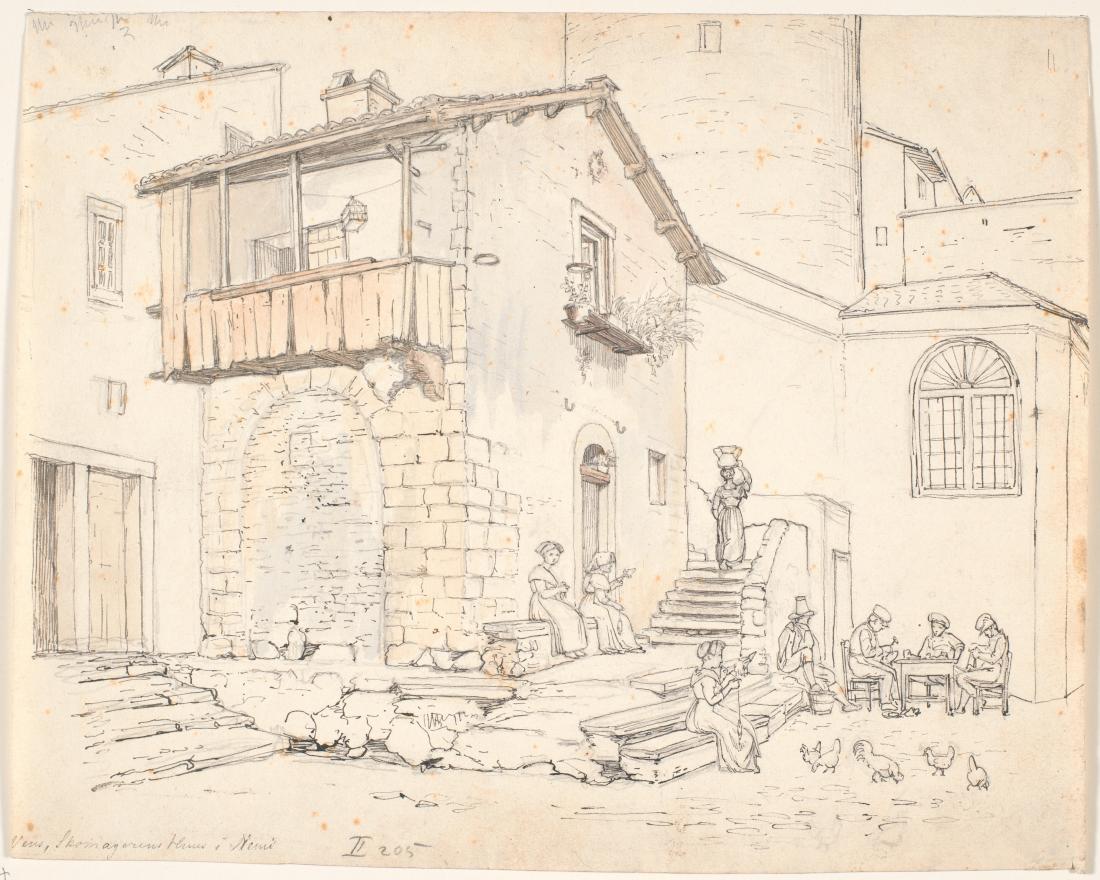
From idea to paper
According to the accepted mythology about Marstrand, it was during his first stay abroad that his rich imagination and tireless capacity for invention seriously proved itself something of a mixed blessing. What we can say for certain is that the sheer amount of impressions now had a palpable impression on his ability or willingness to thoroughly work through every whim and every observation in meticulous studies. One reviewer later remarked that ‘his extraordinary wealth of ideas compelled him to work fast, and the innate ease with which he committed his ideas to canvas was occasionally apparent in his technique’.33 Whatever the case may be, Marstrand would convert the rich seams mined in Italian folk life into rapidly executed sketches and drawings.
One of the things that most clearly sets apart Marstrand from the general throng of his contemporaries is his approach to the medium of drawing. No later than by the summer of 1837, he had gradually tried his hand at using the pen as a drawing tool, which was becoming something of an anomaly among Danish artists. Since the death of Nicolai Abildgaard in 1809 and the arrival of Eckersberg and J.L. Lund as professors nine years later, artists had been encouraged to rate analytical clarity and crisp outlines higher than the dynamic sweep of lines and the picturesque effect of the drawing. Hence, the hard lead pencil had become the preferred tool, while the quill pen – whose elastic line required a certain measure of ease and spontaneity – was ostracised. While Marstrand’s technical experiment may seem rather modest in scope upon cursory inspection, it nevertheless saw him oppose the dominant view of the drawing medium. Initially, he mainly used the pen for Italian street scenes, often incorporating mere hints of watercolour [fig. 19].
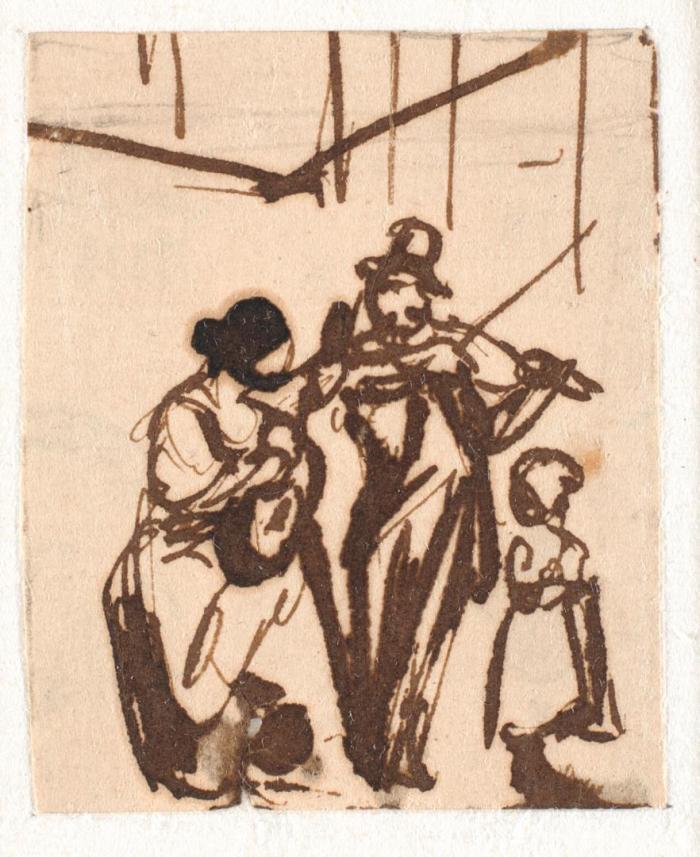
These drawings bear a striking resemblance to what Edward Lear produced during his stay in Rome, and Marstrand could hardly have avoided finding further confirmation and encouragement in his explorations of penmanship through his interaction with his friend. The lessons learned during his time in Rome would later form the basis of Marstrand’s important activities as a draughtsman from the 1840s onwards. For the rest of his career, he was most freely expressive in those drawings where explored the steel pen, the more calligraphic quill pen, the wider reed pen and the painterly wash brush [figs. 20-21].
Over time, these drawings proved very important for the development of Danish art, becoming a benchmark for artists such as Carl Bloch (1834–90), L.A. Schou (1838–67), Otto Bache (1839–1927), Theodor Philipsen (1840–1920) and, ultimately, several of the Skagen painters. The number of such drawings by Marstrand’s hand is so vast that he must certainly qualify as the most prolific Danish artist of the nineteenth century. His drawings can be found in their thousands – and probably tens of thousands – in Danish collections. A contemporary anecdote claims that when Marstrand noticed the prices his drawings were sold for, he actually embarked on a speculative overproduction of drawings for the market. The story is unlikely to be true, for Marstrand was already extremely productive long before he achieved such fame. It is more likely that the drawings acted as Marstrand’s observatory, in the sense that they were how he made his observations on human characters. In a way, Marstrand’s overwhelming drawn oeuvre is a parallel to his colleagues’ far less substantial albums of landscape studies.
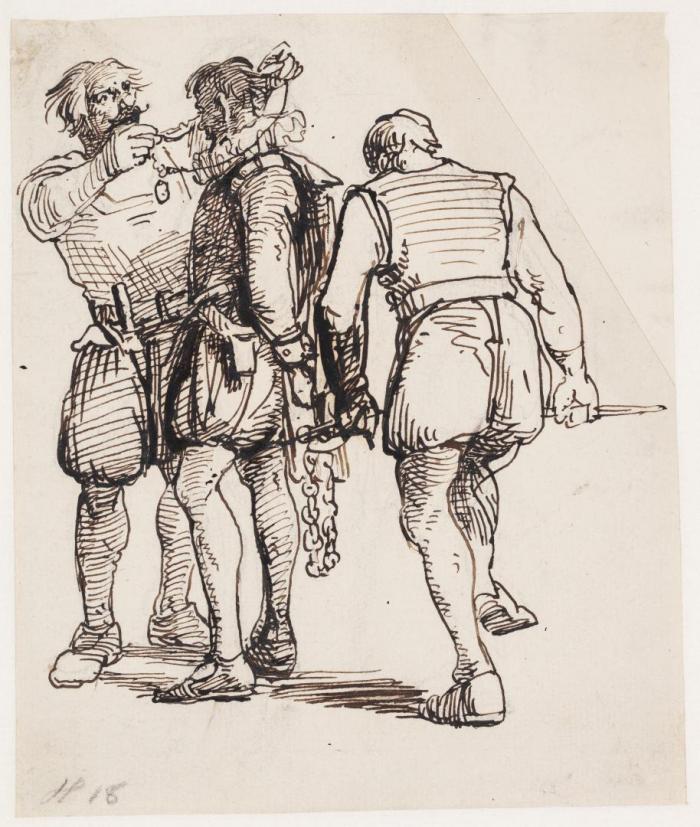
In any case, Marstrand left behind an extremely extensive body of work; upon his death, it took no less than ten auctions to get just a portion of it sold. Although his family kept large numbers of drawings, they ended up holding five auctions featuring more than 5,000 lots in addition to sketchbooks, folders and packages with unspecified leaves. In the decades that followed, these drawings became popular collector’s items, a popularity which did not wane until the interwar period. In the mid-1880s, a single collector owned a collection of more than 400 leaves by Marstrand.34
And when Kunstforeningen (the Copenhagen Art Society) set up a huge Marstrand exhibition in 1898, the drawings had only grown even more popular: almost 2,000 drawings were on display, and many collectors had lent more than fifty pieces to the event; professor Nikolai Bøgh (1843–1905) and the sculptor G.C. Freund (1821–1900) both contributed well over a hundred. Interest peaked around World War I; for example, the painter Frans Schwartz (1850–1917) had 95 framed Marstrand drawings on his walls, while the physician Georg Mentz (1858–1934) built a collection of no less than 258 drawings, also framed. All these figures are provided only to underline the intensity of the cult of Marstrand the draughtsman in the decades following his death. Owning drawings by his hand was quite simply a sure sign of good taste and knowledge of the arts. The prices also reached very high levels in the hysterical market of the war years – in 1916, the Royal Collection of Graphic Art paid no less than 1,100 kroner for the pen drawing The dot on the nose at Mentz’s auction [fig. 22]. At about the same time, a Picasso drawing could be purchased for 100 kroner in Copenhagen.
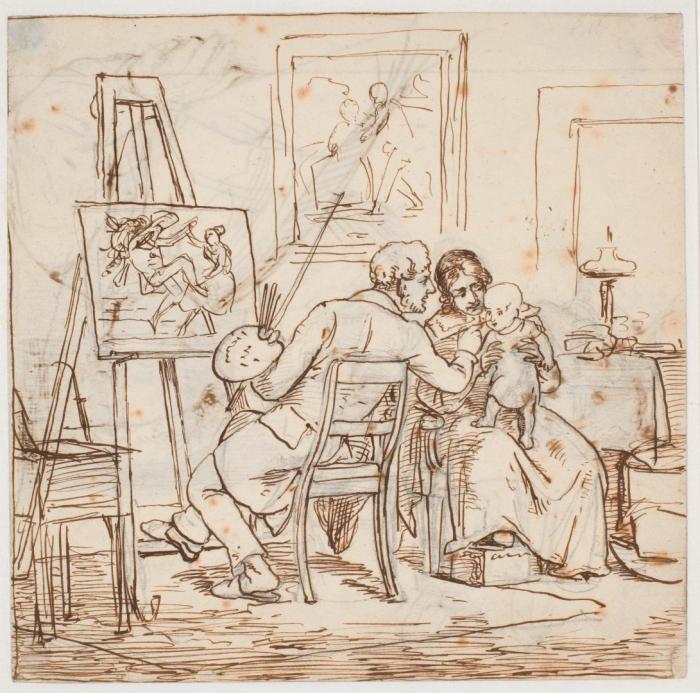
The eager cultivation of Marstrand’s art was quite simply rooted in the fact that the individual drawings were seen as representative of the artist’s wealth of ideas, a quality that was much admired. The ideal was a familiar one, not least from eighteenth-century Italy where the ability to vary a composition elicited great acclaim. In a – possibly apocryphal – anecdote, the art scholar Giannantonio Moschini (1773–1840) relates how the Venetian painter Domenico Tiepolo (1727–1804) had been criticised for a lack of ingenuity, so in order to defy his critics he drew up series of drawings depicting the same subject in a large number of variations.35 Marstrand demonstrated a similar willingness to vary a given motif indefinitely, a trait which Danish collectors valued as highly as their Italian predecessors a century before. By the late nineteenth century, every collector and every art auction was able to show new variants of the same scenes taken from around a dozen literary works or from Italian folk life. As described by Karl Madsen in his 1905 Marstrand monograph, the artist was able to return again and again to subjects he had seen many years before, recreating them in new forms. Hence it is rarely possible to determine whether a drawing is a study or the result of imagination and recollection.36 It was this constant reworking and variation that fascinated posterity.
The curse of Danishness
When Marstrand left Rome in 1840, his initial plan was supposedly to reach Copenhagen without hesitation. Instead, he made a prolonged stop in Munich, where he immediately became part of the city’s vibrant artist community. Here he could socialise with a circle of German-influenced Danish artists, but also, and far more importantly, the local circle of German painters. A central figure was the history painter Peter von Cornelius (1783–1867), who was worshipped with near-religious fervour; Marstrand was one of very few Danes to take part in a party arranged in von Cornelius’s honour.37 However, Marstrand himself was far more enthusiastic about the painter Wilhelm Kaulbach (1805–74), whose praises he sang in a letter to Eckersberg back in Denmark.38 Marstrand soon gained a certain popularity in Munich on his own, eyeing an opportunity to sell repeats of most important paintings from Rome, including variants on the scene from the Feast of Saint Anthony, the prison scene and October Festival Evening Outside the Walls of Rome.39 The fact that this was even possible testifies to diligent effort and clear ambitions: given that in all three cases, the original painting had been shipped ahead to Copenhagen, Marstrand must have brought along tracings that could serve as the basis of any replicas he might have occasion to make.40
Germany remained a lucrative market for Marstrand, who would later also sell works in Frankfurt and Hamburg.41 When Lundbye visited an exhibition in the latter city in 1845, he was startled to come across ‘a small painting by Marstrand: the singing Italian on the staircase; if this is the same one I saw in Copenhagen, it was more to my liking there than here, but I do not believe it is’.42 Marstrand was adept at keeping the German market well supplied with repeats of his own subjects. But if the extended stay in Munich in 1840–41 was beneficial to Marstrand’s European reputation, it also made him accustomed to leading a socially and financially rewarding life on the art scene, which in retrospect was the worst possible preparation for re-entry into the Copenhagen ditto.
When Marstrand finally reached his native Denmark in November 1841, he returned to an art scene in a state of flux and change. During his absence, the national movement had really taken off, and in the visual arts this meant that patriotic depictions of the homeland were the new golden standard. Marstrand’s letters clearly indicate that he – having become accustomed to more international, cosmopolitan settings – persisted in taking an ambivalent and sometimes overtly sceptical view of the national sentiments and their demands regarding the visual arts.43 As early as 1838, he had phrased the dictum he would often repeat, with small variations, ever since: ‘The road they take back home is petty and wrong’.44
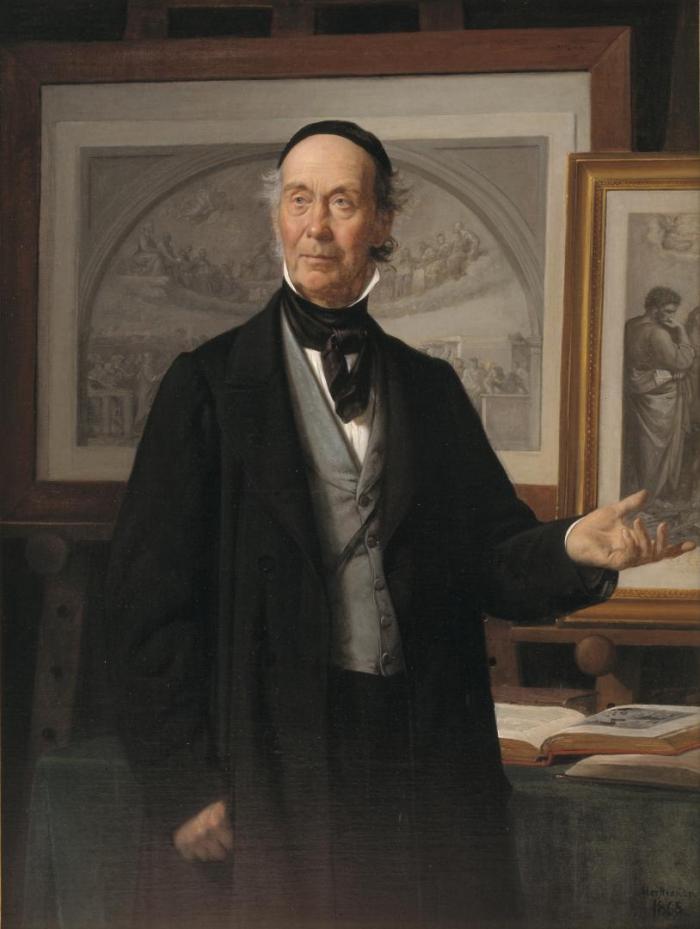
This road was personified by the critic N.L. Høyen, who argued that Danish artists should seek out distinctly Danish imagery, be it from peasant life, the countryside or ancient times. For Marstrand, this ran counter to his own interests and artistic ambitions, although he was able to sympathise with the politics of Høyen and his circle. Accordingly, Marstrand quite naturally slipped into the circle of the powerful critic, but continued to be a somewhat contrary fellow champion for the national cause. His distanced attitude became apparent when he was called upon, many years later, to paint a portrait in tribute of Høyen on the occasion of the latter’s seventieth birthday, but rather surprisingly chose to present the national icon in the process of lecturing on Italian art rather than on contemporary Danish developments [fig. 23].
The 1840s national movement in Danish arts was obviously unsatisfactory for Marstrand, prompting him to quite understandably seek for ways out. When, after his return home, he aspired to be admitted as a member of the Academy of Fine Arts, he had probably hoped to be given the task of painting a scene from southern climes as his admission piece. Instead, he was given the task of painting ‘A Scene of Danish Folk Life’, meaning a genre piece in the national spirit. But if the Academy Council had envisioned an idealised portrayal of healthy, proud peasantry, they would have been most disappointed. While the assignment specified a genre scene, Marstrand chose a literary motif, specifically a scene from Ludvig Holberg’s comedy Erasmus Montanus [fig. 24].
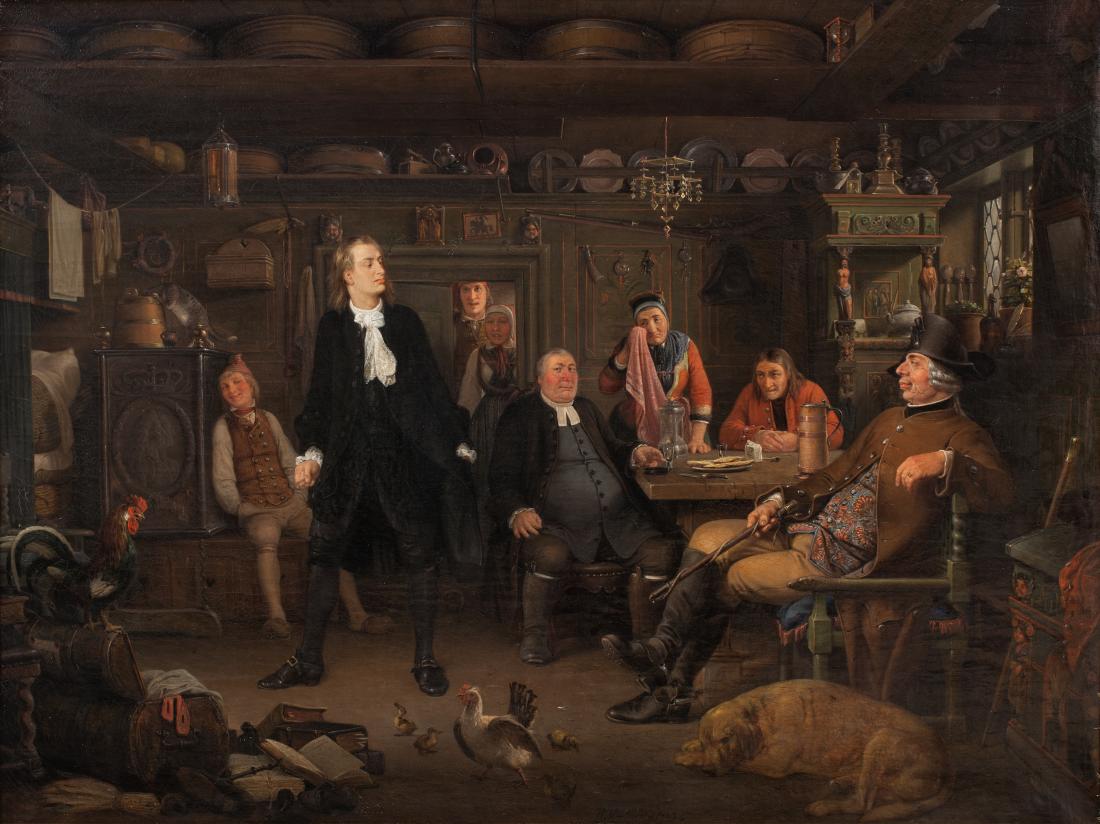
We see the big-headed protagonist disputing with the anything but ideal characters found in his rustic, rural hometown: his drunken father, the addle-minded parish clerk and the cunning bailiff. It seems as if Marstrand sought to reapply the outlook he took on the common folk of Italy, seeing them as simultaneously admirable and comical, repurposing it for a Danish context. In the political climate of the 1840s, it most certainly took courage to subject the rural population of one’s native country to such partial ridicule, but the reference to the great playwright added legitimacy to Marstrand’s endeavour.45 Quite simply, his first Holberg subject saw him hitting upon a golden opportunity for meeting the requirements regarding a suitably national type of art while also catering to his own penchant for satire and storytelling. The Erasmus Montanus painting did indeed bring Marstrand his much-coveted seat on the Academy Council, and he would later go on to explore Holberg’s world in countless paintings and drawings.46
Marstrand’s refreshingly headstrong resistance to those favouring a national outlook did not arise out of his political opinions, but rather out of his adjustment to a cosmopolitan art scene and a more down-to-earth selection of subject matter. Although he did, after his first stay in Italy, remark that ‘sending a Northerner down South is like putting a cod in freshwater’, he nevertheless purposefully sought to leave Denmark behind again.47 Having translated his fame into lucrative commissions for portraits, Marstrand once again set out for Italy in 1845; this time he stayed there for three years. And upon returning home, he resumed his efforts to find ways of evading the ever-growing demands concerning the national roots of Danish art.
He did see eye to eye with the national camp on one point, which was that of common, pan-Scandinavian subject matter. During the First Schleswig War (also known as the Three Years’ War), the well-known author Hans Christian Andersen found himself prevented from travelling south, which prompted him to discover Sweden as a destination instead. At the poet’s recommendation, the newly married Marstrand and his young wife, Grethe, spent their honeymoon in Dalarne in 1851. Seeing Sweden like this gave rise to a marked change of direction for Marstrand, who had now found an opportunity to develop an empathetic outlook on the common people: without any distance, without ambiguity and with unprecedented naturalism. The result was initially an overwhelming amount of drawn studies – probably in the thousands – most of which show the same sincere interest in the people’s way of life, homes, customs and outward appearances. In many ways the Swedish studies are a highlight of Marstrand’s work, and the result, which was ready to be on public display at the exhibition in 1853, was equally much a major masterpiece in his production [fig. 25]. In contrast to virtually all of Marstrand’s earlier depictions of life, he chose here to eschew anecdote and suppress any urge to caricature or beautify. Instead, he has chosen a panoramic scene and gone on to orchestrate the crowd with a tautness of composition more reminiscent of a battle scene than of a rural population assembling on a perfectly ordinary Sunday morning.
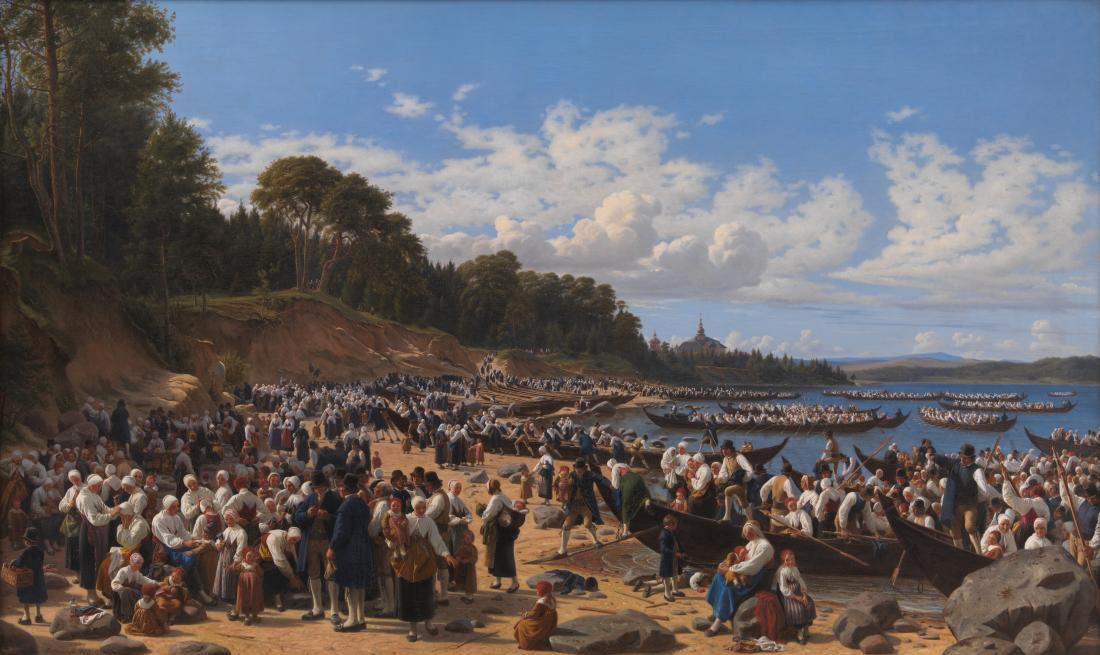
Return to history painting
During his second sojourn in Italy, Marstrand began to practice composing paintings on a more monumental scale. Working on his admission piece of Erasmus Montanus had obviously taught him to play to his strengths and to approach the task of history painting as if it were simply a scaled-up genre painting. In Rome, therefore, he devoted himself to portrayals of folk scenes in similar formats – or even larger. The main result of this endeavour was a genre painting of unusual scale and employing unusual devices: Italian Osteria Scene from 1846–47 [fig. 26]. The subject is as simple as it was unfamiliar at the time: two young Italian women who, upon seeing their chaperone’s attention slipping, seize the opportunity to directly address the viewer, who is cast as the person entering the inn. The subject and its effect were both carefully calculated, and the painting gained immense popularity when it was exhibited back home in Denmark. Perhaps more than any other single work, it helped to secure Marstrand’s fame in his own day, even though its subject matter was not in line with the expectations of those with a more national outlook. Writing home from Rome, he was anything but hopeful: ‘My paintings from here are no longer being bought, now that the people are so firmly required to wear Danish clothes’.48
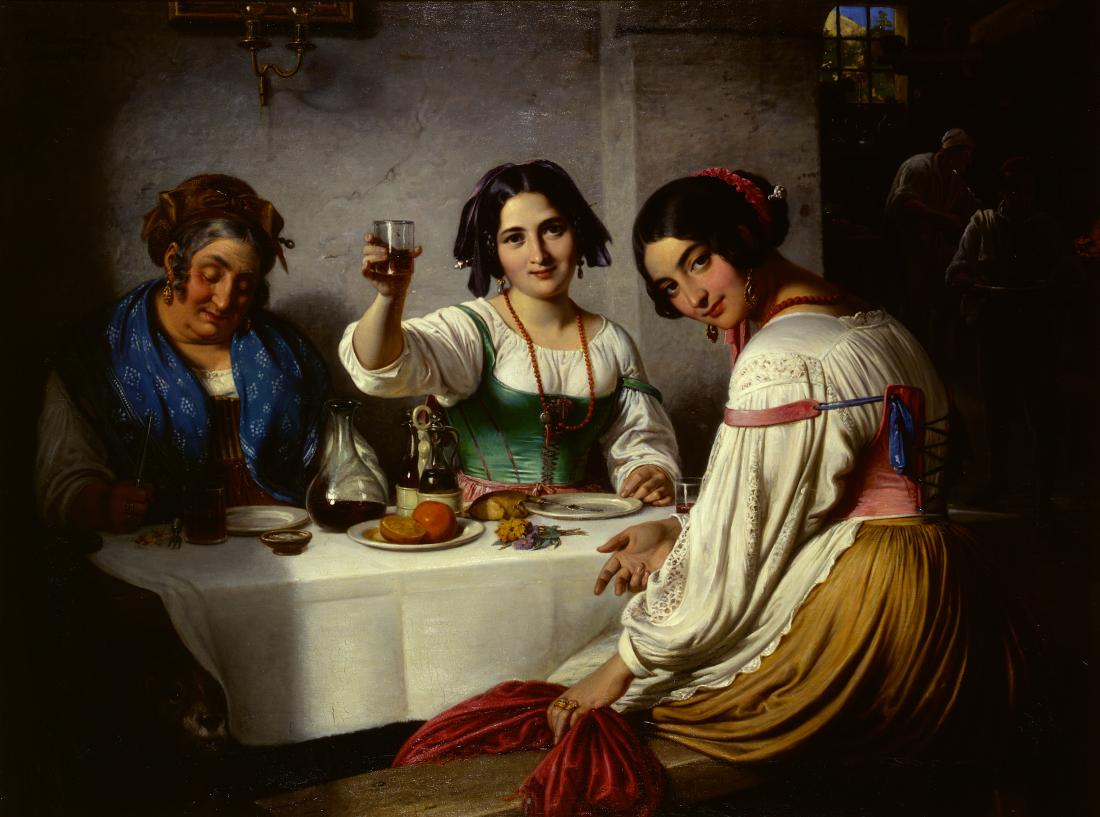
The tremendous popular appeal of the Osteria scene notwithstanding, it would appear that the painting was intended as a deliberate preparation for the major commissions Marstrand believed to have in store for him. At this point, history painting was as yet almost entirely unknown territory to him, and when he toyed with the idea of decorating the Ceremonial Hall of the University of Copenhagen in 1846, he clearly felt the need to justify his sudden ambition. He allowed himself to entertain such ideas:
even though it might be more appropriate for my talent to attend to the humorous aspects of public life rather than to the higher strata of the historical; at any rate everyone is asking why I do not continue in the vein that they say I have proven myself so peculiarly well suited to and leave the rest to others, but my reasons have been partly the prospect of being able to get a considerable commission for public work in my home country and thus have something that would call me home in earnest, and partly I did not think that the more serious subjects are quite so far out of my grasp, and also I knew of no-one back home who could give such images a lively and picturesque quality in addition to the stricter architectural form; whether I can do so will now be the question.49
Approximately one year after his return to Denmark, Marstrand’s efforts began to pay off. In the autumn of 1848, a professorship became vacant at the academy’s model school, traditionally a position taken by history painters.50 Marstrand immediately sent an application, as did his friends and fellow artists Jørgen Roed and Niels Simonsen (1807–85). The decision was in the hands of the Academy Council, which included Eckersberg, J.L. Lund, N.L. Høyen and H.W. Bissen. In their statement to the press, they announced that Marstrand was elected unanimously, although Simonsen had in fact obtained a single vote. It would appear disagreement among the power elite of art was not considered good form, not even in the birth year of Danish democracy.
In the past, the Academy’s professors of painting had generally been history painters, partly in order to ensure a steady supply of history paintings to the reigning king, but that particularly function seems to have been considered secondary when making this appointment. As a professor, Marstrand succeeded the recently deceased Martinus Rørbye, who had also not followed the usual career path of academy professors, which tended to favour gold medals and a firm dedication to history painting. Also, with Danish democracy having just been instated, there were good reasons to expect a decline in demand for decorations for castles and churches. Only very few altarpieces were commissioned, although in fact this was an area where Marstrand truly shone. A huge altarpiece for Faaborg Church, representing the Supper at Emmaus, is composed with striking light effects, the disciples’ dark profiles set against the smouldering evening landscape, while the profile of Christ is illuminated by a shining halo against the dark back wall. The effect is both theatrical and decorative, and had the commissions for such works been more plentiful, Marstrand might have become one of the most enduring church artists of his generation.
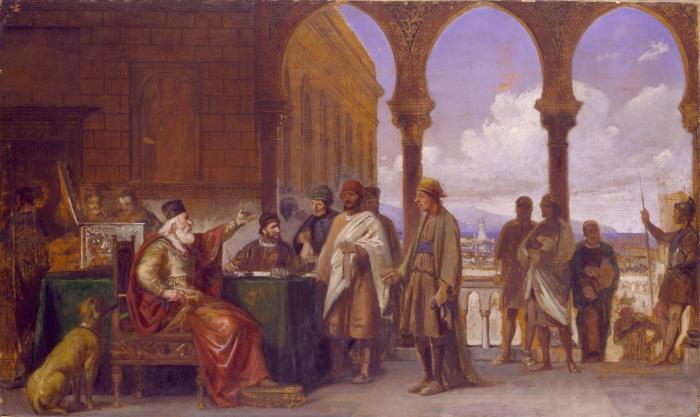
Similarly, Marstrand was not assigned many secular commissions for public artwork, and some of the most important tasks that did fall to Marstrand remained unfinished. In the Ceremonial Hall of the university he only managed to paint one of three planned picture fields, and a projected decoration for the National Bank of Denmark never got beyond the promising sketch stage [fig. 27]. However, Marstrand did complete one commission of this kind – and did it so successfully that it has since shaped generations of Danes’ perception of history. The work in question is Marstrand’s contribution to Christian IV’s chapel in Roskilde Cathedral, where he partly portrayed the king’s shrewd interference in a trial, and partly how, during the Battle of Colberger Heide, he was hit in the eye by shrapnel [a sketch depicted in fig. 28]. The latter image, which Marstrand painted directly onto the wall in oil paints, is undoubtedly his most iconic and recognisable work, the subject of endless reproductions.
Marstrand’s official career culminated when he was appointed Director of the Royal Danish Academy of Fine Arts in 1853, a position he held until 1857 and again from 1863 until his death. As a professor as well as a director, he had the opportunity to be an internationally oriented voice in the art world, yet he never truly became the innovator of the academic system he once aspired to be. In 1854, Constantin Hansen blamed his friend for travelling to Italy at a time when there was certainly enough to do back home for the newly-appointed Academy Director – and, what is more, a time when the Academy’s centennial attracted tremendous attention to the question of the course set for the institution. Apparently, the youthful urge for rebellion could not offset Marstrand’s tendency toward pessimism and disillusionment, traits that were only reinforced by his academic positions.
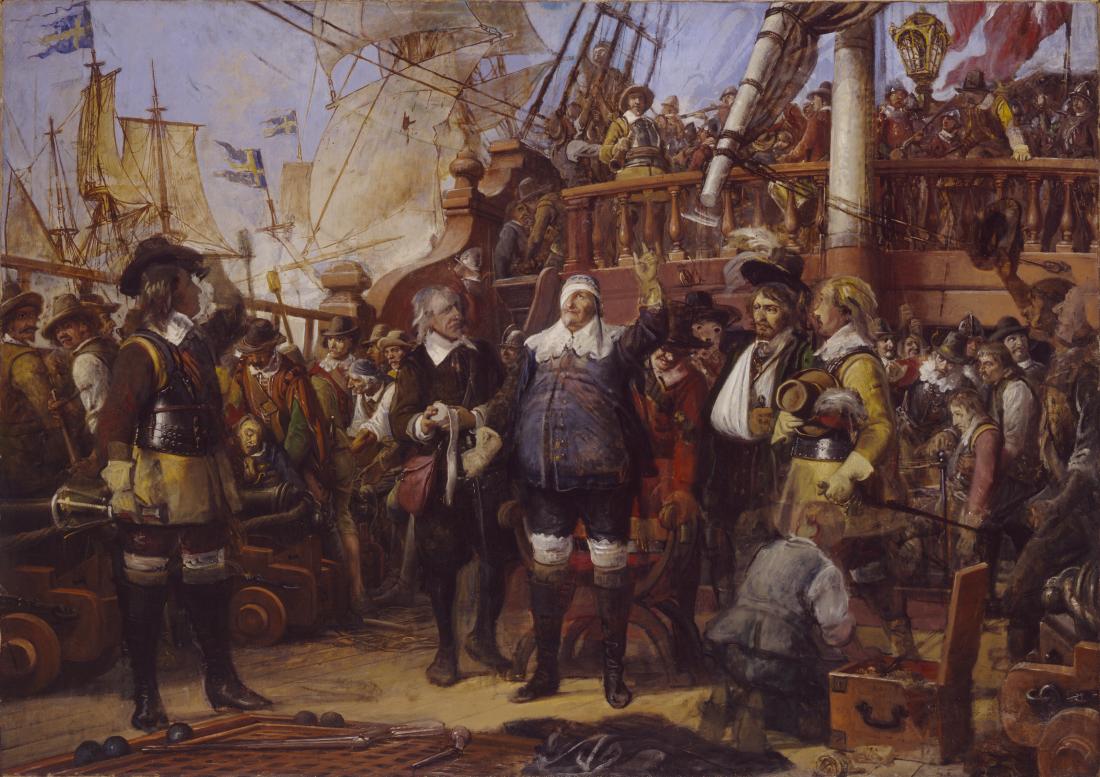
The anti-hero enters the stage
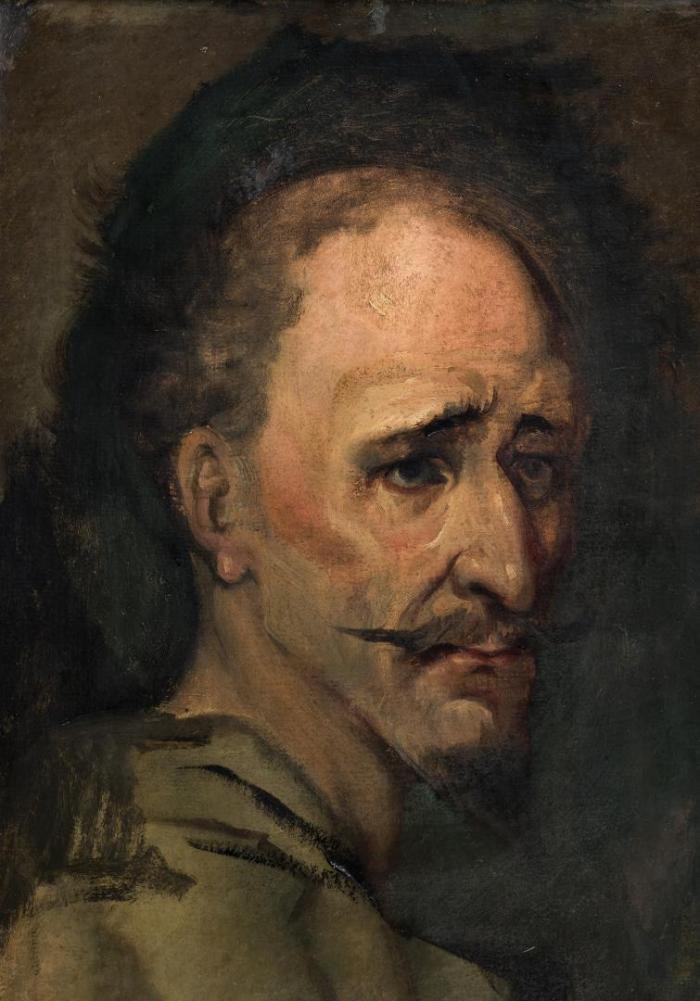
Marstrand’s first Holberg scenes in the 1840s ushered in an extensive and long-standing exploration of literary subjects. Not since Abildgaard had a Danish painter drawn on a similarly wide body of reading. Marstrand was personally acquainted with several writers of the day, such as Hans Christian Andersen, H.P. Holst and J.L. Heiberg, but even so the writers of the previous centuries appealed most directly to his imagination. Strikingly, he particularly chose the anti-heroes of literature as subject matter – especially tragicomic characters who fool only themselves. During his second trip to Italy in the mid-1840s, he painted his first scenes featuring the character of Don Quixote. In the 1850s, the character would become a recurring guest in a wealth of drawings and paintings [fig. 29].51 In art history literature, the Don Quixote scenes have been interpreted as an autobiographical metaphor for Marstrand’s own position and self-image: the misanthropic professor supposedly saw himself reflected in the broken dreamer whose flighty imaginary world must inevitably be crushed by a reality that reduces him to a tragic figure.52 While such an interpretation may seem somewhat speculative, it would not be unprecedented in the art of the time; one can find autobiographical elements in the use of literary motifs in many of Marstrand’s fellow artists, not least Eckersberg.53 And Marstrand had himself demonstrated similar tendencies in 1842 when, having suffered a broken-off engagement and having his dreams of family life dashed, he began to paint and draw a wealth of lovers and proposal scenes.54 Indeed, his exploration of the absurdities of the Don Quixote character also took place entirely parallel to his own ever-more pessimistic view of the Danish art scene and his own abilities.
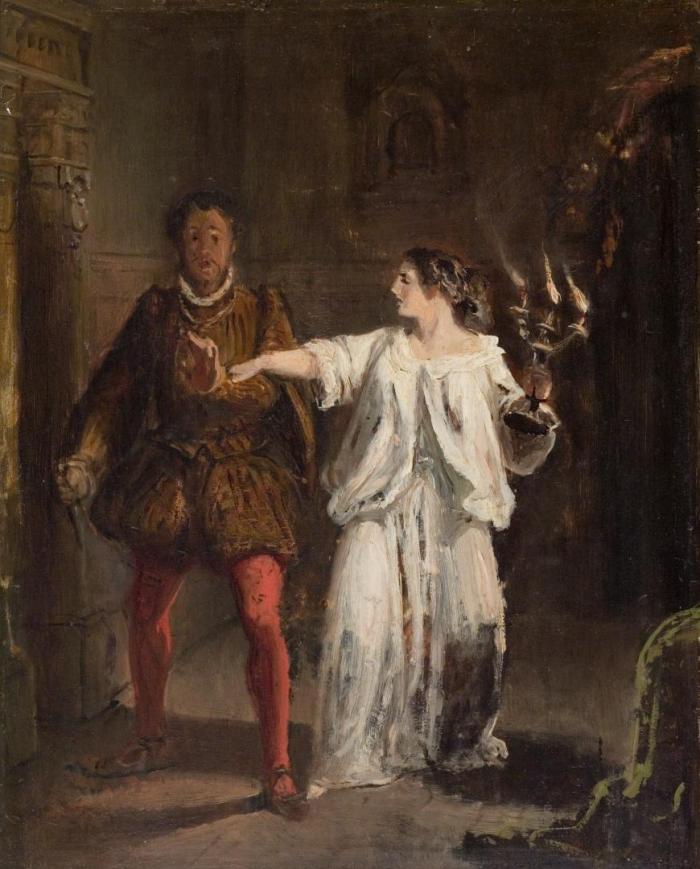
However, Holberg’s comedies and Don Quixote were not the only literary works that would get Marstrand’s famous stream of images flowing. In the 1860s, Shakespeare also entered his repertoire, even though by this point the Bard had supplied very little subject matter for Danish paintings since the days of Abildgaard [fig. 30]. But unlike his friend Adam Müller, who was one of the very few Danes to address Shakespearean themes, depicting a scene with Lady Macbeth in 1831, Marstrand would rarely let sombrely dramatic episodes find their way to his canvases. Instead, he sought out the more comedic characters of the plays – above all the blustering and corpulent John Falstaff, whom we find depicted in several of Marstrand’s drawings. With just a few exceptions, the literature of the seventeenth century never became fertile ground for Marstrand, who preferred to look to writers of the eighteenth century instead, finding far more subjects in not only Holberg but also Charlotte Dorothea Biehl (1731–1888), Carl Michaël Bellmann (1740–95), Johann Wolfgang Goethe (1749–1832) and their contemporaries.
Marstrand also looked to the eighteenth century when his urge to self-reflection became a definite theme from the mid-1860s onwards. Instead of literary subjects, Marstrand now portrayed scenes from the authors’ own lives, particularly comic moments with Holberg at the centre and more tragic episodes with Johannes Ewald (1743–81) and Johan Herman Wessel (1742–85) as protagonists.55 This sudden interest in the life of the actual authors coincided with the fact that Marstrand now found himself hailed as a genius, which would hardly have sat well with own self-image, beset with doubts. In 1865 the art historian Julius Lange (1838–96) – who represented the discipline of art history, still in its infancy, which helped identify the specificities of Danish culture after Denmark’s defeat in 1864 – called Marstrand a comic genius on a par with none other than Holberg and Wessel. In the eyes of Lange, Marstrand was ‘without doubt the richest and greatest talent that has yet come to maturity within Danish painting’.56 Marstrand’s depictions of the authors’ lives as well as his enduring fascination with anti-heroes such as Don Quixote, Peder Paars, Erasmus Montanus and John Falstaff may be seen as a somewhat ambivalent response to the unexpected reverence of his supposed genius and his growing doubts about the artist’s role in society.
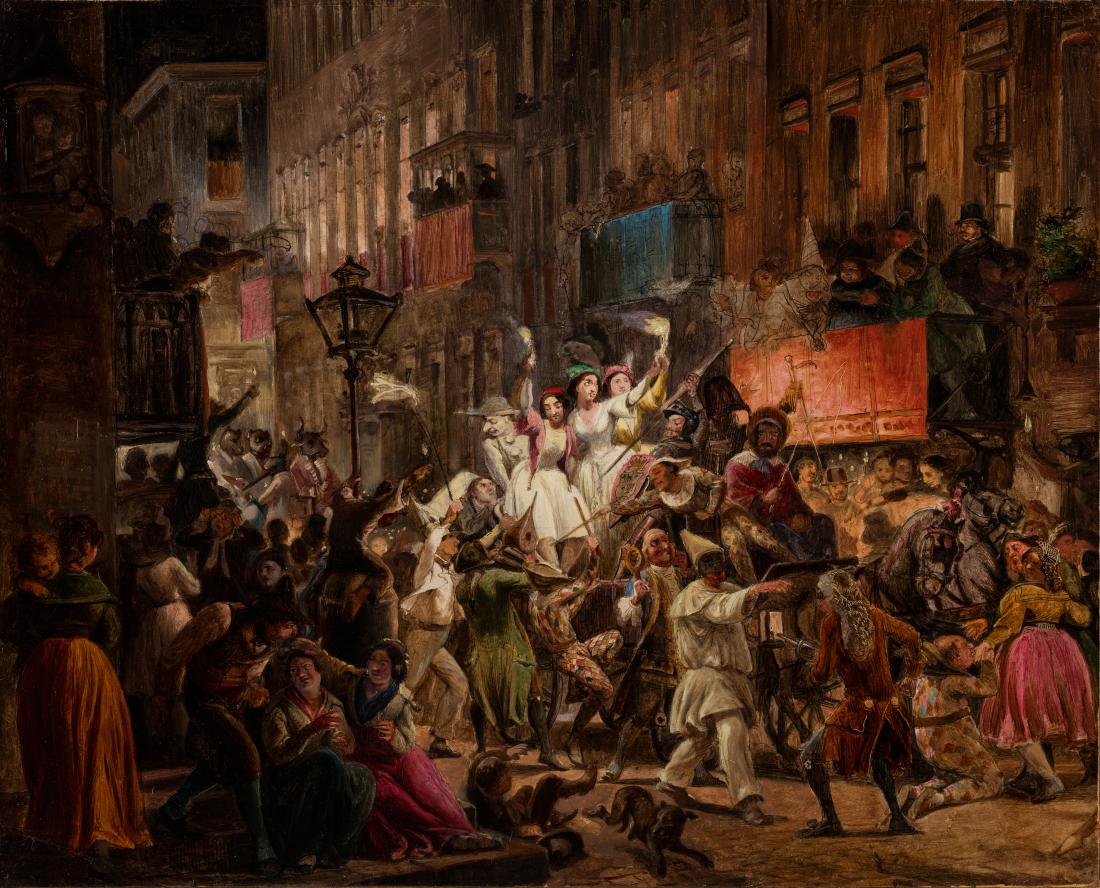
Marstrand’s late painting
As a painter, Marstrand can hardly be called a great technician, and he seems, on the whole, astonishingly inconsistent in his exploration of oil paints. Only in his late work, and only in glimpses does one find fairly persistent efforts at innovation in terms of his palette and use of colour. The first intimations of this painterly phase came during his second stay in Italy with the brightly sparkling Moccoli scene depicting the festival of light that marked the end of the Roman carnival. Marstrand sold the finished work in Germany, so today we only know it through an oil sketch [fig. 31]. Simultaneously cheerful and highly evocative, the scene features intensely smouldering colours that had not previously appeared in his work. He did not try to repeat the experiment anytime soon.
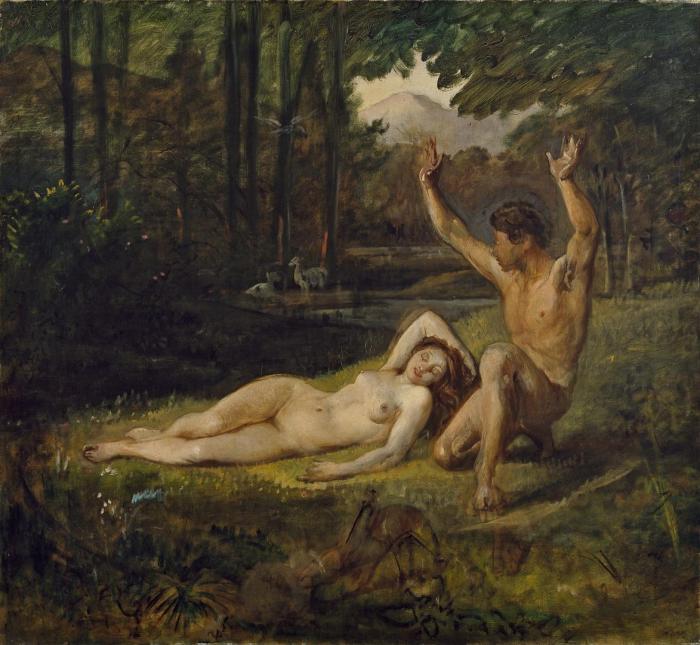
Not until the second half of the 1850s did Marstrand begin to develop his palette in a direction never seen before in a Danish context. While Høyen regarded the painters’ ability to painstakingly hide their brush strokes as their most important quality, Marstrand now tried his hand at painting with wider strokes and with such arbitrariness that the colours would sometimes become muddled on the canvas [fig. 32]. He seems to have initially been particularly drawn to Venetian role models whom he had studied during his trip to Venice in 1854.57 An obvious example is the Parable of the Talents [fig. 27], its airiness and colour scheme as well as its open space and the tactility of the textiles clearly reminiscent of Paolo Veronese (1528–88). The typically Venetian horizontal composition also provided ample space for auxiliary figures and objects, which, very much in the spirit of Marstrand, added an element of genre painting to the history painting. Later, Marstrand also became aware of contemporary French painting, and at the International Exhibition in London in 1862 he was probably one of the only Danish artists of the time to particularly admire the landscapes created by one of his peers, the French artist Théodore Rousseau (1812–67).58
Marstrand’s late paintings did not always meet with universal appreciation, particularly because the results of his experiments could be somewhat uneven and random. After his death, one critic noted that ‘Marstrand has sometimes, and perhaps rightly so, been criticised for adopting, in his later years, a mode of treatment so broad and slapdash that it bordered on mannerism’.59
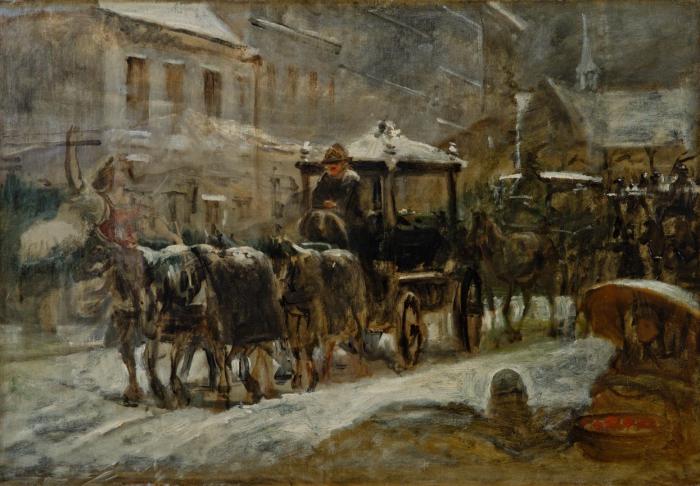
Yet even though his late paintings might sometimes seem somewhat awkward in their representation of form and rather blurred in terms of colour, they arise out of a deliberate pursuit of painterly freedom. Even a subject like a hearse in the street could, ironically, be depicted by means of lively and energetic strokes [fig. 33].
While the art collectors and art historians of posterity would be attracted by Marstrand’s wealth of ideas and ability to vary a given subject almost indefinitely, the painterly breadth of his late work tended to be the main appeal in artist circles. The generations of painters who had the French school of painting as their ultimate ideal saw the aging Marstrand as a Danish counterpart to Eugène Delacroix (1793–1863). P.S. Krøyer, who laid down the foundation of his art collection at the age of 22 by purchasing pieces at the auctions of Marstrand’s estate, was a good example of the artists’ continued reverence for their great role model.60 Later, Krøyer would also acquire Marstrand’s late oil of Adam and Eve, giving it a prominent position in his studio [fig. 34-35].61 One might easily form the idea that the downcast eyes of one of these figures and the raised arm of the other figure, extending up into the foliage above, served as inspiration for the work occupying Krøyer’s own easel at the time, the now-famous Hip! Hip! Hurrah!
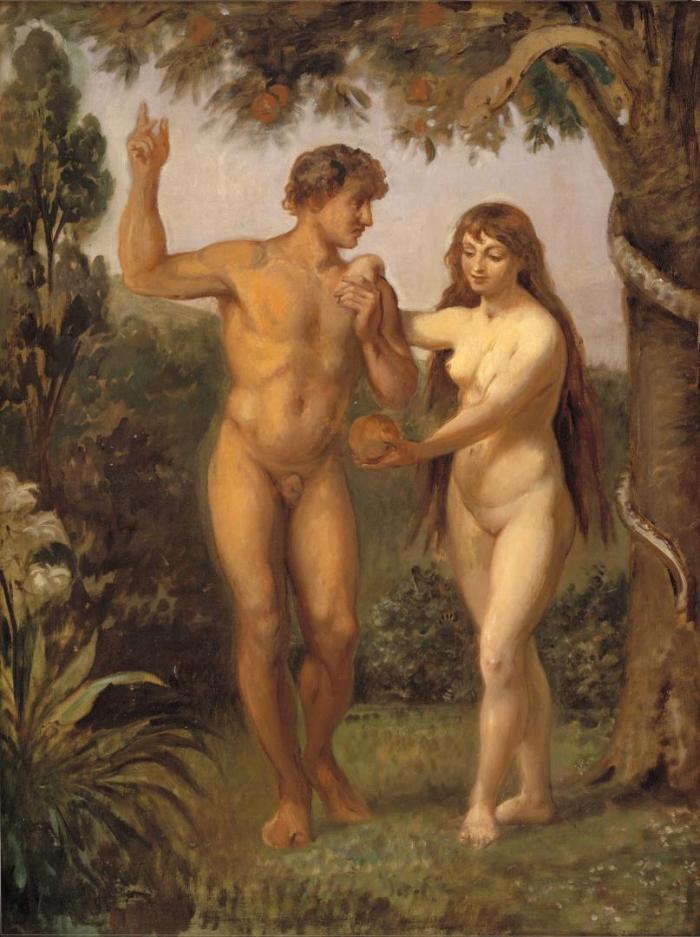
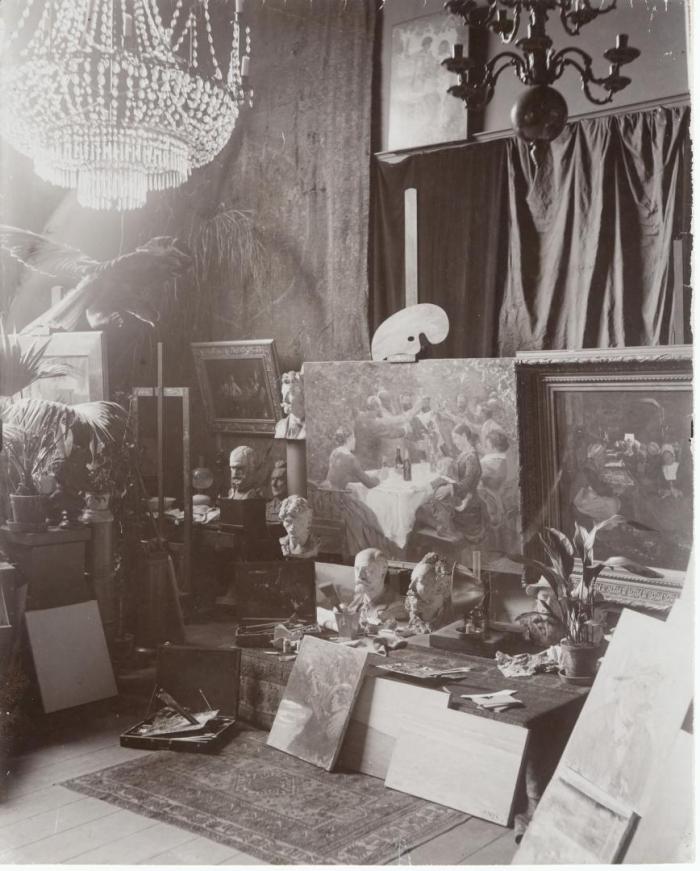
The Marstrand Cult
Overall, Marstrand was the object of adulation and idolatry on a scale that may be difficult to properly understand for present-day observers. For example, the first of the annual Charlottenborg salons held after Marstrand’s death featured a memorial presentation of some of his paintings, surrounded by black crape and symbolically flanked by Carl Bloch’s The Entombment of Christ and The Resurrection.62 As was mentioned above, the Marstrand cult lasted until around the time of World War I, after which his popularity waned rapidly. Modernist expressive force supplanted a joy in storytelling and imagination as an artistic ideal, and the sheer volume of Marstrand’s flow of images was no longer enough to impress. A new generation of artists, collectors and critics saw only his technical imperfections and tendency towards anecdote. His portrayal of people was interpreted as merely superficial, and his sense of humour was misunderstood as distinctly unsympathetic and brutal. The latter was perhaps only to be expected. Time hardly ever works in favour of the humour of a given period; it rarely ages well. It is no wonder, then, that Marstrand’s brand of humour became outdated and may fall flat in the eyes of present-day audiences. In fact, the truly surprising thing is that his humour proved so viable that it could still be enjoyed, found amusing and elicit enthusiastic praise half a century later.
Marstrand’s reputation as a humourist ultimately proved a stumbling block for the proper understanding his other endeavours, and he has rarely – and only with great difficulty – been subjected to sober observation stripped of either idolatry or condemnation. Marstrand’s incessant stream of images and his almost infinitely vast production quite simply make it difficult to clearly identify his distinctive character. But as the previous pages have shown, his work is infused by efforts to circumvent the many expectations and demands he met: whether the academic demands for serious storytelling encountered as a student, the 1840s and their somewhat inflexible notions about what genuinely national Danish art should look like, or the pressure to be a figure of innovation during his years as a professor. Marstrand’s response to all these external expectations was to seek other avenues, for example by using humour as a means to serious ends, by cultivating unfamiliar literary motifs from tales of anti-heroes, or by pursuing freer techniques of painting. All this regardless of the ever-present risk of failure. Yet above all else, the pervasive theme of Marstrand’s work is a striving to portray human traits in the simplest form possible and an ability to speak into the general public’s thirst for narratives. Having been banished for decades now, the tide appears to be turning for Marstrand’s narrative paintings. One senses a renewed interest in the genre painting of the time, which is once again appreciated for its mischievous joy in storytelling, for its depictions of human life and, in Marstrand’s case, for its ironic but well-meaning observations on man as a social being.
Bibliography
Henrik Bramsen: Kunst i enevældens sidste hundrede år, Copenhagen 1990
Charlotte Christensen: Guldalderens billedverden, Copenhagen 2019
Karina Lykke Grand: ’Det nye blik’ in: Guld. Skatte fra den danske guldalder, ARoS Aarhus Kunstmuseum, Aarhus 2013, pp. 168-197
Bent Holm: ’Omkring Marstrands Holberg’ in: Nivaagaard viser Marstrand, Nivaagaards Malerisamling, Nivaa 1992, pp. 55-74
Anton Jepsen: Det kongelige Møbelmagasin og københavnersnedkerne. Danske møbler efter 1777, s.l. 1991
Ejner Johansson: De danske malere i München. Et ukendt kapitel i dansk guldalderkunst, København 1997
Julius Lange: ’Nyere dansk Genremaleri’ in: Dansk Maanedsskrift, 1865, II (reissued in Billedkunst, Copenhagen 1873, pp. 119-259)
Lars Olof Larsson: ’Diogenes in der Lavendelstræde. Kommentare zu einem Gemälde von Martinus Rørbye’ in: Annegret Heitmann and Karin Hoff (eds.): Ästhetik der skandinavischen Moderne. Bernhard Glienke zum Gedenken, Frankfurt am Main 1998, pp. 281-287
Karl Madsen: Wilhelm Marstrand, Copenhagen 1905
Karl Madsen: ’Tilvæksten i Museets repræsentation for Marstrand’ in: Kunstmuseets Aarsskrift, IV, 1917, p. 1-28
Otto Marstrand: Maleren Wilhelm Marstrand, Copenhagen 2003
Giannantonio Moschini: Dell’ Incisione in Venezia, Venice 1924
Nivaagaard viser Marstrand, Nivaagaards Malerisamling, Nivaa 1992
Niels Jørgen Poulsen: ’Udsigt fra Gåsetårnet 1823. Om C.W. Eckersbergs og Jacob Marstrands panorama’ in: Nationalmuseets Arbejdsmark 1987, pp. 63-74
Michael Kiaer Raffenberg (ed.): Vilhelm Marstrand. Breve og Uddrag af Breve fra denne Kunstner, Copenhagen 1880
Lene Bøgh Rønberg: ’Borgerligt hjemmeliv i de to guldaldre – Påvirkninger og sammenhænge’ in: I lyset af Holland, Statens Museum for Kunst, Copenhagen 2001, pp. 74-141
James Byam Shaw: The Drawings of Domenico Tiepolo, London 1962
Jesper Svenningsen: C.W. Eckersberg. Værker fra Kunstmuseet Brundlund Slot, Aabenraa 2017
Jesper Svenningsen (ed.): Seks år af et liv. Johan Thomas Lundbye — Dagbøger om tro, skæbne, kunst og kærlighed, Copenhagen 2018
Jesper Svenningsen: ‘Fra indforstået vid til platte vittigheder. Humor i 1820’ernes og 30’ernes malerkunst’ in: Dansk Guldalder. Verdenskunst mellem to katastrofer, Statens Museum for Kunst, Copenhagen 2019, pp. 249-265
Peter Swaab: ‘”Some Think Him … Queer”. Loners and Love in Edward Lear’ in: Edward Lear and the Play of Poetry, James Williams and Matthew Bevis (eds.), Oxford 2016, pp. 89-114
Gitte Valentiner: Wilhelm Marstrand. Scenebilleder, Copenhagen 1992
Jenny Uglow: Mr. Lear. A Life of Art and Nonsense, London 2017

